本帖最后由 seven_nana 于 2024-9-17 18:23 编辑
日德兰纪念系列 - 军舰建造篇 - 第一章 - 英国海军的两强标准
本帖内容未经允许不得转载
主要参考资料:
From the Dreadnought to Scapa Flow, Volume I, The Road to War, 1904-1914, 作者Arthur J. Marder
Sir John Fisher's Naval Revolution, 作者Nicholas A. Lambert
In Defence of Naval Supremacy: Finance, Technology, and British Naval Policy, 1889-1914,作者Jon Tetsuro Sumida
The Genesis of a Cruiser Navy: British First-Class Cruiser Development 1884-1909,作者Scott M. Lindgren
Warrior to Dreadnought: Warship Design and Development 1860-1905,作者D. K. Brown
The Grand Fleet: Warship Design and Development 1906-1922,作者D. K. Brown
British Battleships 1889-1904,作者R. A. Burt
British Battleships of the Victorian Era,作者Norman Friedman
The British Battleship 1906-1946,作者Norman Friedman
British Cruisers of the Victorian Era,作者Norman Friedman
British Cruisers: Two World Wars and After,作者Norman Friedman
British Destroyers: From Earliest Days to the Second World War,作者Norman Friedman
一、英国海军的造舰需求
英国是一个游离于欧洲大陆之外的岛国,人口和面积都不甚出众,因此在很长一段时间内,英国的国力都是不如法国的。然而,随着英国海上力量的不断增强,以及英国海外殖民地的不断拓展,至18世纪末期时,英国已经发展成为了一个强大的海上帝国和殖民帝国。随后,在拿破仑战争中击败了法国之后,英国成为了世界上的头号强国。当时的大英帝国,拥有着遍布全球的众多殖民地,从北美洲的加拿大、大洋洲的澳大利亚和新西兰、亚洲的印度、再到非洲的大片土地,都在英国的管辖范围内,因此当时的大英帝国也被称作是日不落帝国。在一战前夕时,大英帝国所统治的陆地面积和人口,都占到了全世界的近1/4,是有史以来最为庞大的帝国。而这些殖民地与英国本土之间的人口及物资流动,都是依靠海上交通来维系的。因此,英国需要一支强大的海军,来维护自身的利益。
英国海军的高层管理机构
在具体介绍造舰工作之前,我们先来了解一下英国海军的高层管理机构。根据Arthur J. Marder的说法(From the Dreadnought to Scapa Flow, Volume I, The Road to War, 1904-1914, P.19-20):
The Board of Admiralty was the supreme naval authority, wielding the powers of the King and of His Majesty's government. The pivot and centre of the whole was the First Lord of the Admiralty. It is the British tradition that the First Lord is responsible to the Cabinet, and ultimately to Parliament. All Board members must be responsible to the First Lord...It was not unusual in the eighteenth century for a high-ranking officer to hold the office of First Lord...But since the early nineteenth century the First Lord has invariably been a civilian...The other 'Lords Commissioners of the Admiralty' consisted of the four sea lords-all naval officers-and two civil lords and two chief secretaries. There had been doubt for many years as to the exact position and responsibilities of the First Sea Lord, and, indeed, of the other Board members. The distribution of business was chaotic, with everyone having a finger in everyone else's pie. This chaos ended on 1904...The new definition of duties made it quite clear that the First Sea Lord was responsible for the 'fighting and sea-going efficiency of the Fleet', and that he was the chief professional adviser of the First Lord. The Second Sea Lord was responsible for the manning and training of the Fleet; the Third Sea Lord (the Controller), for design of ships and, later, aeroplanes and airships; the Fourth Sea Lord, for the transport service and naval stores; the Civil Lord, for works, buildings, and Greenwich Hospital. An Additional Civil Lord was created in 1912 (until 1917) for handling contracts and dockyard business. Finally, there were the Parliamentary and Financial Secretary, who had to be an M.P., and the Permanent Secretary, the only civil servant on the Board. The former looked after financial matters, such as the navy estimates. The latter was concerned with general office organization and correspondence and served as an expert on procedure and precedent.
英国海军的最高权力机构,叫做海军部委员会(Board of Admiralty),该机构负责行使国王及政府赋予其的权力。在海军部委员会中,位居领袖位置的是海军大臣(First Lord of Admiralty)。根据英国的传统,海军大臣需要向内阁和议会负责。在18世纪时,由高阶海军军官担任海军大臣的例子有不少,但进入19世纪后,该职位就一直是由文官来担任了。除了海军大臣以外,海军部委员会内还有4名海务大臣、2名民事大臣、以及2名高阶秘书,他们都需要向海军大臣负责。在1904年以前,这些岗位的职责并没有得到明确的规定,因此经常会出现某个人插手别人的工作的情况。至1904年时,岗位职责得到了明确,其中第一海务大臣(First Sea Lord)负责舰队的航海能力及战斗能力,同时也是海军大臣的首席军事顾问;第二海务大臣(Second Sea Lord)负责舰队的人员配置和训练工作;第三海务大臣(Third Sea Lord/Controler)负责军舰建造,后来还负责飞机和飞艇(第三海务大臣是造舰工作的总负责人,具体工作则交由造舰局长、军械局长、轮机总监等人负责);第四海务大臣(Fourth Sea Lord)则负责物资储备与运输工作;民事大臣(Civil Lord)负责管理各类海军建筑物、工厂、医院;在1912-1917年间,还额外增设了一名民事大臣(Additional Civil Lord),负责签订合约、以及管理港口事务;至于那两位高阶秘书,分别是由议会成员担任的议会及财政秘书(Parliamentary and Financial Secretary),以及由公务员担任的常务秘书(Permanent Secretary),其中议会及财政秘书负责财政事务,例如海军预算,而常务秘书负责海军部委员会的日常管理工作,同时他也是各种规章制度方面的专家。
英国海军需要建造的军舰类型
1、在19世纪末至20世纪初时,英国海军会建造战列舰、巡洋舰、以及轻型舰艇这三种类型的军舰,来满足国家战略的各方面需求。根据Nicholas A. Lambert的说法(Sir John Fisher's Naval Revolution, P.15-16):
Throughout late-nineteenth and early-twentieth centuries the British government expected the Royal Navy to perform three main tasks: first, and foremost, the navy was to dominate the narrow seas and approaches to the British Isles and so prevent invasion; second, the navy was to secure communications with the colonies, and particularly the route through the Mediterranean to India; and third, the navy was held responsible for the preservation and security of the global trading system upon which the prosperity of the nation depended. This involved patrolling the ocean trade routes, charting and surveying, suppressing piracy, and generally protecting British and imperial trade from interference.
在19世纪后期及20世纪初期时,英国政府期望皇家海军能履行三项主要职能:第一,海军应能牢牢把控住狭海,以及通往不列颠群岛的航路,从而阻止敌人入侵英国本土,这也是海军最基础的职能;第二,海军应能确保英国本土与各殖民地之间的交通线路,尤其是经由地中海通往印度的交通线路;第三,由于大英帝国的繁荣是建立在全球贸易的基础上的,因此海军应保护全球贸易体系,确保其安全性。这意味着英国海军需要在海上贸易路线上进行巡逻,勘探海域并绘制海图,打击海盗行为,并保护帝国治下的各种贸易行为免遭干扰。
In return, it was always understood that the Royal Navy would be provided with ample forces to ensure a maritime predominance over any reasonable combination of other European great powers. This meant sufficient line-of-battle ships to be sure of a decisive victory in engagements against enemy main fleets, enough cruising vessels to protect maritime trade from interference, and a supply of flotilla craft (chiefly gunboats) for imperial constabulary duties and to perform the minor operations of war.
作为对应,英国海军会获得充足的海上力量,来确保其具备统治性的海上实力,从而能应对来自其他欧洲国家,甚至是互相结盟的欧洲国家共同对英国构成的挑战。这意味着皇家海军需要装备足够数量的战列舰,以确保其在舰队交战中能够取得决定性的胜利;意味着要装备足够数量的巡洋舰,从而保护海上贸易,使其免遭敌方的干扰;同时还意味着要装备各类轻型舰艇(主要是炮舰),从而在各殖民地区域维持帝国的统治,并应对小规模的战斗。
2、在这些军舰中,最受重视的是战列舰,但巡洋舰和轻型舰艇也有各自的价值。根据Nicholas A. Lambert的说法(Sir John Fisher's Naval Revolution, P.38-39):
History taught the Board of Admiralty that the power which possessed the strongest line of battle could invariably rely upon this superiority to intimidate weaker enemy battle fleets; they would remain in port, thus leaving the stronger power with effective command of the sea. Once this “moral superiority” had been established, the stronger power could then deploy its cruisers and flotilla craft off the enemy coast. These “inshore squadrons” could watch enemy ship movements, interdict the enemy’s overseas trade, guard against the possibility of an invasion fleet putting to sea, and intercept commerce raiders. All the while, the squadrons of battleships would remain close by ready to inflict a crushing blow on the enemy main fleet when the opportunity arose. This strategy had been repeatedly proven effective during the age of sail, and at the end of the nineteenth century the Board of Admiralty could see no reason to abandon it for another.
在海军部委员会看来,历史经验证明,拥有最强大的战列舰队的国家,始终都可以凭借这一优势,恫吓住敌对方的战列舰队——后者会龟缩在港口内,因此战列舰队的实力更强的那个国家,就能有效掌控制海权了。在确立了这种“优越感”之后,实力更强的那个国家,可以将巡洋舰和轻型舰艇部署到敌国的海岸线上。这些近岸部队,能封锁敌方的海上贸易,观察敌方军舰的动向,拦截敌方的袭击舰,并在其派出大规模舰队时发出警示。与此同时,那个国家的战列舰队,则会在附近的海域待命,并在时机到来之时,与敌方主力舰队进行决战。在风帆海军时代,这种战略已经被屡次证明是行之有效的。在19世纪末时,海军部委员会信奉的依然是这种战略。
英法俄争霸与两强标准
在19世纪后期时,对英国的海上霸权构成挑战的国家,主要是法国和俄国。当时的英国的海军建设,主要就是针对这两个国家的海上威胁的。
1、在1870-1880年代,英国海军的造舰节奏,是比较缓慢的。根据Jon Tetsuro Sumida的说法(In Defence of Naval Supremacy: Finance, Technology, and British Naval Policy, 1889-1914, P.11-12):
During the 1870s, Britain had built relatively few new warships, while continental naval powers such as France had made considerable additions to their fleets. The Carnarvon Committee of 1879, which had been formed in order to investigate naval deficiencies that had been revealed in the mobilization against Russia the year before, concluded, therefore, that the navy was far too small to carry out the tasks that would be required of it in war. But their call for immediate and substantial new warship construction, which was to be supported by a considerable increase in taxation, was not carried out. Public anxiety over Britain’s naval vulnerability led to the announcement in 1884 of a five year scheme of greater expenditure on new warship construction, named the “Northbrook Program” after the First Lord. Increases in spending on naval building in 1885-86 and 1886-87 were followed, however, by reductions in 1887-88 and 1888-89.
在1870年代时,英国建造的军舰数量并不多;相比之下,法国等欧洲大陆国家,则新建造了不少军舰。在1878年时,为了遏制俄国的扩张企图,英国海军曾进行过动员,并因此暴露出了不少问题。为了调查这些问题,在1879年时,英国政府成立了一个调查委员会,来研究此事。由于该委员会的主席是第4代卡那封伯爵,因此也被称为是卡那封委员会。根据其调查结论,当时的英国海军的规模太小了,无力承担其应尽的战时职责。该委员会呼吁,应立刻着手建造大量军舰,但由于造舰意味着需要大幅增税,因此政府并未采纳该建议。对于英国海军实力不足的问题,英国社会表达出了担忧之声,于是英国政府在1884年时,宣布了一项为期5年的造舰计划。由于当时的海军大臣是第1代诺斯布鲁克伯爵,因此该计划又被称为“诺斯布鲁克计划”。在接下来的1885-86及1886-87财年,海军造舰费用有所增长,但在1887-88及1888-89财年,造舰费用则有所下滑。
Britain’s failure to build greater numbers of warships in the 1870s and 1880s had much to do with both the continued confidence of her political leadership in her overall naval, financial and economic strength. But problems with the budget must also have been an important factor. During this period, large amounts were expended annually to cover the costs of major colonial military operations in Afghanistan and in Africa. And while serious disagreements with Russia in 1878 and 1885 did not lead to war, considerable sums had to be spent upon the emergency expansion and precautionary mobilization of military and naval forces.
在1870至1880年代时,英国之所以没有建造大量军舰,一方面是由于政治家们仍然对英国海军的实力,以及英国本身的财政和经济实力存在充分的信心,但另一方面,也与当时的英国政府预算紧张有很大关系。在这一时期,阿富汗和非洲地区的殖民地军事行动,耗费了大量的金钱。另外,在1878和1885年时,英国与俄国出现过尖锐的矛盾,尽管最终并未爆发战争,但为了应对这些危机而进行的紧急扩军和预防性海陆军动员,也都耗费了大量的金钱。
During the late 1880s, the worsening international situation increased British anxiety about naval security. In early 1888, a war scare with France again led to public clamor for naval expansion, and by the end of the year there were ominous signs of an impending Franco-Russian alliance that would possess nearly as many battleships as Britain...In the meanwhile, reductions in non-naval spending had greatly improved the financial position of the government...After 1885, moreover, Britain restricted her colonial military activity and was able to avoid further major confrontations with great powers. Large budget surpluses were thus achieved in the late 1880s in spite of a slight fall in the level of revenue...By the end of the 1880s, it had thus become possible to spend much more on the navy without recourse to the politically dangerous alternatives of borrowing or greatly increased taxation.
在1880年代后期,不断恶化的国际环境,加深了英国对于海上安全问题的担忧。在1888年初时,英法之间出现过战争风险,这导致了英国社会上出现了加强海军的呼声。至1888年底时,更是出现了法俄同盟的征兆,要知道,这两个国家所拥有的战列舰数量之和,几乎是与英国海军相当的。与此同时,由于非海军领域的财政开支大幅减少,因此英国政府的财政状况得到了显著的改善。在1885年后,英国的殖民地军事行动也减少了,因此也降低了与其他列强发生大规模冲突的可能性。于是,在1880年代后期时,尽管英国政府的财政收入略有下滑,但却拥有了大幅的预算盈余。正因如此,他们终于能够在不进行大幅增税或大额举债的情况下,即不冒政治风险的情况下,大幅增加海军支出了。
2、为了应对来自法俄两国的威胁,在1889年时,英国海军部提出了一套庞大的造舰计划。根据D. K. Brown的说法(Warrior to Dreadnought: Warship Design and Development 1860-1905):
In June 1887 White sent a memo to the Board drawing attention to the number of ships which were obsolescent, or would become so within the next 5 years. His paper included very detailed proposals for the number and type of replacement ships together with planned building schedules and a detailed estimate of the rate of spending. Altogether, he proposed the scrapping of seventy-two obsolete ships and their replacement by modern vessels at a cost of £9 million. Reaction within the Board was mixed; The First Naval Lord and the Controller propose an alternative programme and the full Board then considered both proposals.
1887年1月,当时担任英国海军造舰局长的威廉·怀特,向海军部委员会(Board of Admiralty, 英国海军的最高决策机构)提交了一份备忘录,并列出了英国海军编制下已经老旧落伍、以及在接下来的5年内即将变得老旧落伍的军舰。怀特提交的备忘录中,还包含了非常详细的旧舰替换建议,列出了需要替换的军舰种类与数量、对应的造舰计划、以及预计需要花费的造舰经费。他建议拆解72艘老旧落伍的军舰,而用于替代它们的新舰则需花费900万英镑建造。对于这份备忘录,海军部委员会的各位成员,有着不同的反应——第一海务大臣和第三海务大臣持有不同的意见,并提交了他们的方案。随后,整个海军部委员会对这两份提案进行了评估。
There was a strange report in June 1888 that the Naval Lords were satisfied with the strength of the Navy and did not recommend a large building programme. This may merely have been the tradition support given by public servants to their minister but the First Lord’s statement accompanying the 1888 Estimates suggests a more fundamental cause. He said that there had never been a full study of the naval requirements of the Empire; that the procedure had been for the First Lord to get as much money as he could from the cabinet and for the Board to do the best they could with those funds. White’s memo and the questions raised about it by Lord Hamilton had forced a more fundamental examination. The final proposal was for a somewhat bigger programme than that put forward by White but differing little in principle. The Board proposed that over the following five years the building programme should include ten battleships, thirty-seven cruisers and eighteen torpedo gunboats.
在1888年6月时,出现了一份奇怪的报告。在这份报告中,海军部委员会中的职业军官们表示,他们对英国海军的实力感到满意,并且不建议推行大规模的造舰计划。这种说辞,或许只是遵循传统,对政府表达支持(当时的政府并不愿意花费大量金钱来建造军舰)。但从海军大臣针对1888年海军预算所发表的声明来看,或许另有隐情也未可知。海军大臣表示,一直以来,都没有人针对大英帝国的海军需求,做过完整的研究。事实上,一直以来的做法,就是海军大臣尽其所能向内阁申请经费,随后由海军部委员会决定,应该如何使用这笔经费。但在怀特提交了那份备忘录后,在汉密尔顿勋爵(当时的海军大臣)提出了这些问题后,英国海军不得不对此做出更为彻底的评估。海军部委员会最终拿出的造舰方案,在基本方针上与怀特的提议类似,但在规模上则要更加庞大——他们提议,在接下来的5年内,建造10艘战列舰、37艘巡洋舰、以及18艘鱼雷艇。
In February 1889 a report on the Naval Manoeuvres 1888 by Admirals Dowell, Vesey Hamilton and Richards was presented to both Houses of Parliament. This report showed that the Navy was ‘altogether inadequate to take the offensive in a war with only one great power...and...supposing a combination of two great powers to be allied as her enemies, the balance of maritime power would be against England.’ This restatement of the Two Power Standard carried great weight. Finally, on 7 March 1889, Lord George Hamilton introduced the Naval Defence Act authorising the building of seventy ships between 1889 and 1894 at a cost of £21.5 million.
1889年2月时,英国上议院和下议院同时收到了由多位海军将领共同提交的有关1888年海军演习的报告,其中指出:“在与一个列强国家开战的情况下,我国海军的实力完全不足以开展进攻性作战;如果我们与两个联手的列强国家开战,那么我国海军的实力将会处于劣势”。这份声明是掷地有声的,并且重申了英国海军曾经采用过的两强标准。最终,在1889年3月7日时,海军大臣乔治·汉密尔顿勋爵,向议会提交了海军防务法案,提议在1889至1894年间,花费2150万英镑,建造70艘军舰(10艘战列舰、42艘巡洋舰、以及18艘鱼雷艇)。
3、如前所述,两强标准并不是1889年时才出现的,但汉密尔顿勋爵为其赋予了新的含义。根据Nicholas A. Lambert的说法(Sir John Fisher's Naval Revolution, P.18-19):
The first lord explained his formula to Parliament. "I have endeavoured to study the speeches of those who in previous years have held my position and that of Prime Minister, so as to ascertain what was the paramount idea underlying their utterances when they spoke of the standard at which our naval establishment should be maintained, I think I am correct in saying that the leading idea has been that our establishment should be on such a scale that it should at least be equal to the naval strength of any two other countries."
这位海军大臣,向议会解释了他对两强标准的理解:“我花了大量精力,去研究历代首相和海军大臣们所发表过的讲话,以便弄明白一个核心问题——当他们谈及我国海军应具备的实力水准时,在其言辞之下,想要表达的关键信息到底是什么?对此,我认为我已经得出了正确的答案——我们的海军实力,应至少相当于任意两个国家的海军力量之和”。
"Supremacy at sea," he observed, "must, after all, be measured by the number of battleships we can put into the line." Elsewhere in his speech, the first lord insisted that only up-to-date types would be counted toward the new standard; this was a very significant departure from established practice and represented a concession to those who had argued that older battleships would be of little use in a real war. Deleting older vessels also provided justification for new construction. As to how he intended to calculate his "two-Power standard," as it became known, Hamilton remained deliberately vague. At the very least it meant a modern British battleship force numerically equal to the combined battleship fleets of the next two strongest naval powers; at the most it provided for a fleet certain of containing the combined fleets of the next two strongest naval powers or, in quantitative terms, a British battle fleet approximately 10 to 15 percent larger than that of her potential opponents. Equality plus a margin, in other words.
汉密尔顿勋爵表示:“海上霸权,是以能够投入战斗的战列舰的数量来衡量的”。这位海军大臣还强调,在计算海军实力时,只应考虑新式军舰的数量。他的这个观点,与之前所遵循的惯例是截然不同的。在此之前,已经有人表示,在真正的战斗中,那些老式的战列舰是没有多大价值的。汉密尔顿勋爵的这番言论,显然就是在向这种观点做出让步。至于这个两强标准到底应该如何计算,汉密尔顿勋爵则是故意地含糊其辞了。以最低标准而论,那意味着英国的新式战列舰的数量应相当于第二和第三海军强国的战列舰数量之和。以最高标准而论,英国的新式战列舰数量,则应大于第二和第三海军强国的战列舰数量之和,具体数值是英国舰队应在数量上享有10-15%的优势。换句话说,就是两强有余。
4、尽管两强标准强调的是战列舰的数量,但巡洋舰的数量同样是非常重要的。根据Nicholas A. Lambert的说法(Sir John Fisher's Naval Revolution, P.20-21):
Britain's naval leaders held serious concerns at the available number of modern cruisers suitable for protecting the empire's oceanic trade. In a scheme for the defense of trade prepared during the 1885 war scare, they calculated on the Royal Navy being able to augment its force of eighty-three trade protection vessels with at least seventy-five armed merchant ships. By 1892, however, the Admiralty had recognized that an auxiliary cruiser would be no match for a modern warship, and the plan to use armed merchant ships as cruisers was consequently shelved, There was no alternative, the naval lords argued, other than to build more cruisers. The Admiralty estimated that to provide adequate protection to British trade in time of war, the Royal Navy would require at least twice as many cruisers as its prospective opponents. In other words, twice as many as those possessed by the Franco-Russian combination.
英国海军高层还面临着一个非常严重的问题:英国海军需要巡洋舰来保护帝国的海上交通线,但新式巡洋舰的数量,却是严重不足的。在1885年时,为了应对战争风险,英国海军准备了相应的通商保护计划。根据当时的计算,海军拥有83艘能够用于通商保护的军舰,此外还至少可以获得75艘武装商船,来增强其实力。但是,至1892年时,海军部意识到,辅助巡洋舰(即武装商船)是无法与新式的军舰相抗衡的,因此他们放弃了将武装商船作为巡洋舰来使用的计划。海务大臣们表示,除了建造更多的巡洋舰之外,别无他法可循。根据海军部的估算,为了能在战争时期保护英国的海上贸易,皇家海军的巡洋舰数量,应至少达到其潜在对手的两倍。换句话说,就是法俄两国的巡洋舰数量总和的两倍。
5、汉密尔顿勋爵还宣称,海军防务法案将能阻止军备竞赛,但事实却并非如此。根据Jon Tetsuro Sumida的说法(In Defence of Naval Supremacy: Finance, Technology, and British Naval Policy, 1889-1914, P.15-16):
The First Lord maintained that the large building program would discourage the naval aspirations of rival powers, which would enable Britain to reduce her naval building in later years. The completed program, Hamilton believed, would be “adequate not only to our immediate, but also to our future wants” because it was “one which I do not think all the Dockyards of Europe would complete in the time we propose.”
这位海军大臣强调,这种大规模的造舰计划,能够打消敌对势力的海军扩张的企图,从而让英国得以在接下来一段时间内,减少海军建设的开支。汉密尔顿勋爵认为:“整个造舰计划,不仅能满足我们当下的需求,还能满足我们未来的需求,因为即便是把整个欧洲大陆的造船厂加在一起,都无法在我们所规划的时间周期内完成如此庞大的造舰规划”。
The Naval Defence Act did not, however, have the restraining effect on the warship building of rival powers that Hamilton had predicted. Between 1889 and 1893, France and Russia, who were the two next largest naval powers after Britain and from August 1891 formal allies, laid down 12 battleships, and by the end of 1893 had announced plans to lay down an additional five such vessels at the beginning of 1894. Britain, in comparison, had built 10 battleships under the Naval Defence Act, laid down one battleship under the estimates of 1892-93, and projected two battleships under the estimates of 1893-94. By 1893, moreover, relations between Britain, and France and Russia, had deteriorated seriously as a result of disagreements over Siam, Afghanistan, and Egypt. After bitter debate, the Cabinet formally agreed on 8 March 1894 to a five year program named after Lord Spencer, the First Lord, which authorized the construction of 7 battleships, 20 cruisers and over 100 flotilla craft at a cost of £21,263,000.
然而,汉密尔顿勋爵所推出的海军防务法案,并未像他预期的那样,遏制住敌对势力的军舰建造工作。法国和俄国,即当时仅次于英国的两个海军强国,在1891年8月时正式签订了盟约。在1889至1893年间,这两个国家总共开工了12艘战列舰,并且在1893年底时还宣布,他们将于1894年时再开工5艘战列舰。作为对比,英国则根据海军防务法案,建造了10艘战列舰,此外还在1892-93财年时建造了1艘战列舰,并且还打算在1893-94财年再建造2艘战列舰。另外,在1893年时,英国与法俄两国之间的关系,也由于在暹罗、阿富汗、埃及等地的矛盾,而不断恶化。在经过尖锐的争辩后,英国内阁在1894年3月8日时,正式同意了一项为期5年的造舰计划。这项计划叫做斯宾塞计划,其名称源自当时的海军大臣斯宾塞勋爵,该计划将花费2126.3万英镑,建造7艘战列舰、20艘巡洋舰、以及超过100艘轻型舰艇。
结论:在1870年代时,英国海军的军备建设是相对比较松弛的,但进入1880年代后,受到法俄两国的威胁,英国海军开始加强军备建设。在1889年的海军防务法案及1893年的斯宾塞计划的助力下,英国海军开启了大量建造军舰的节奏。他们的目标,是将英国海军的实力维持在达到或超越法俄两国之和的水准。
二、英国海军的战列舰
在各类军舰中,战列舰(Battleship)的吨位最大,装备的火炮数量最多,装甲防护水准最强,具备最强的战斗能力。
1、在当时的海军中,战列舰是最重要的舰种,这不单单源于其战术价值,还源于其战略威慑作用。根据Norman Friedman的说法(The British Battleship 1906-1946):
Battleships were hardly the full sum of British naval power, but they were certainly its most expensive element. The battle fleet of which they formed the most impressive part was conceived as a shield behind which large numbers of lesser ships could exercise such vital naval roles as protecting British commerce - the life-blood of the Empire - and interdicting the enemy’s commerce. Similarly, the shield could support operations abroad: anyone trying to stop those operations had to get past the battle fleet. Anyone contemplating an invasion of the British Isles had to deal with a battle fleet capable of wiping out his invasion shipping.
战列舰并不是英国海军力量的全部,但显然是其中最为昂贵的组成部分。由战列舰所组成的战列舰队,是海军中最让人印象深刻的组成部分,能够为其他军舰提供坚实后盾的作用。在战列舰的支持下,其他的吨位较小、但数量众多的其他军舰,就能履行保护大英帝国的海上交通命脉,或阻碍敌国的海上贸易的职能。除此之外,这些后盾还能用于支持在海外开展的军事行动:但凡有人想要阻止这类军事行动,他们就必须要先解决英国战列舰队。另外,若是有人想入侵不列颠群岛,那也需要先解决英国战列舰队,否则其入侵船队可能会被英国战列舰队歼灭。
2、在19世纪中后期时,风帆战列舰被铁甲舰所取代,随后在铁甲舰的基础上,又演变出了现代意义上的战列舰。根据Norman Friedman的说法(British Battleships of the Victorian Era):
Before the age of steam and armour, ships did not become obselete. Their lifetimes were set by the strength of their hulls...The crisis of the Victorian era was that the technology kept changing so fast that new ships became obsolete long bofore they wore out. It must have been particularly difficult to convince statesman to spend heavily on a new generation of ships when it must have been obvious that whatever was modern one year would be obsolete a few years later. That is why the Royal Navy's battle fleet of the 1870s and 1880s was a 'fleet of samples'. This process really ended only with the Naval Defence Act of 1889. The Act coincided with that seem to be a period of stability in battleship technology.
在风帆战列舰时代,军舰的寿命主要是取决于船体强度的,只要舰体强度没问题,船本身是不会过时的。当铁甲和蒸汽取代了木壳和风帆后,由于技术发展日新月异,因此在维多利亚时代中期时,即便是新建造的战列舰,很快也会变得过时。在此情况下,想要说服议会成员,花大价钱建造一堆没过几年就会落伍的军舰,显然会是非常困难的。正因如此,在1870至1880年代时,英国海军的战列舰队,是由一群五花八门的军舰共同构成的。一直要到1889年海军防务法案落地后,这种情况才得以改变——原因在于,当海军防务法案得以通过之时,战列舰相关的科技,差不多也进入了一个较为稳定的状态。
3、19世纪末至20世纪初的战列舰,通常被称为前无畏舰,这些军舰具有相似的核心特征。根据Norman Friedman的说法(The British Battleship 1906-1946):
Between about 1890 and 1900, a standard type of battleship emerged, armed with four heavy guns in twin mounts, a battery of ten to fourteen quick-firing guns of roughly 6in calibre, lighter anti-torpedo (boat) guns and torpedo tubes, plus machine guns which could be used against exposed enemy personnel at short battle ranges. Initially the logic of such a design was connected with the nature of battleship armour. It took very thick, hence very heavy, armour to resist the most powerful shells. A ship of affordable size (12,000-14,000 tons) could not carry much side armour beyond a waterline belt. In battle, the slow-firing heavy guns (firing a shell every few minutes) would attack the belt and thus the ship’s vitals. The quick-firing guns, of roughly 6in calibre, would attack the unarmoured side of the ship.
在1890至1900年间,出现了一种标准形态的战列舰。她们配备以下几种类型的武备:搭载在2座炮座内的4门大口径火炮,安装在炮廓内的10-14门速射炮(口径在6英寸左右),若干门口径更小的反雷击火炮,用于在近距离上射击敌舰上暴露在外的人员的机枪,以及鱼雷发射管。之所以会有这样的设计模式,核心原因在于战列舰的装甲防护设计——只有大厚度的装甲,才能抵挡威力最强的炮弹。由于大厚度装甲的重量也很大,因此在合理的尺寸(12,000-14,000吨)下,只有在水线区域附近,才可能安装大厚度的装甲。在战斗中,低射速的大口径火炮(每隔几分钟才能射出一发炮弹)会用来攻击敌舰的装甲带,即其舰体核心区域;而6英寸左右口径的速射炮,则会用来攻击敌舰的无防护区域。
4、在前无畏舰时代,英国战列舰是有一等和二等之分的。根据D. K. Brown的说法(Warrior to Dreadnought: Warship Design and Development 1860-1905):
Centurion and Barfleur: The provisions of the Naval Defence Act included two ‘Second Class’ battleships, their intended role was as a ship of force in China and the Pacific. Their likely opponents were big Russian cruisers, whilst shallow draught (26ft) was essential to operate on the Chinese rivers.
在海军防务法案中,包括有2艘百夫长级二等战列舰。这型军舰是设计用来派驻至亚太地区的,她们的主要潜在对手是俄国海军的巡洋舰。另外,为了能在中国的河流(主要指长江)中航行,这型军舰的吃水也是比较浅的(26英尺)。
Renown...it was decided to build a third Centurion...develop a much superior design. Her novelty lay in her armour; the middle deck sloped down at at the sides to meet the lower edge of the belt. The sloping edge of the deck provided a very strong support to the belt but, more important, any intact shell which penetrated the main belt would be slowed in doing so and then hit the slopes, which it would be unlikely to penetrate. This style of protection was used in every British ship up to Hood.
再后来,英国海军又计划再建造1艘百夫长级,不过实际建造的声望号,在设计上要比百夫长级先进不少。其主要优势,在于采用了新式的装甲防护布局:其防护甲板靠近舰体两侧的区域,是向下倾斜,并与主装甲带的下沿相连的。从舰体结构的角度来看,这种倾斜布置的防护甲板,为主装甲带提供了强有力的支撑;更重要的是,从装甲防护的角度来看,即便来袭炮弹击穿主装甲带,其动能也会损失不少,因此就不太可能再击穿倾斜布置的防护甲板了。在英国军舰上,这种装甲防护布局,一直沿用到了胡德号战列巡洋舰。
5、尽管整体设计风格类似,但随着子系统技术的进步,较为新锐的前无畏舰,在战斗力上还是要显著超越较为老旧的前无畏舰的。根据Jon Tetsuro Sumida的说法(In Defence of Naval Supremacy: Finance, Technology, and British Naval Policy, 1889-1914, P.18-19):
The Harvey process of face-hardening, which was first tested in 1891, resulted in armour plates that were far more resistant to both penetration and cracking than those made of conventional nickel-steel. The use of Harvey armour, together with adoption of a sloping armoured deck, made it possible to build first-class battleships under the 1893-94 estimates and Spencer program that were better protected than their Naval Defence Act predecessors. Krupp armour, which was produced by more sophisticated methods of face-hardening that made it considerably harder and tougher than even Harvey armour, appeared in 1894. The use of Krupp in the place of Harvey armour, and the decision to accept a lower standard of protection to the hull amidships for the battleships ordered under the estimates of 1896-97, allowed a greater area of the hull to be covered by armour.
1891年时,哈维表面硬化处理工艺出现了。相比于常规的镍钢装甲,采用这种工艺后,装甲抵御炮弹攻击的能力有了很大的提高,并且装甲本身也不那么容易开裂了。通过采用哈维硬化装甲及倾斜布置的防护甲板,1893-94财年及斯宾塞计划中建造的一等战列舰(威严级),获得了比海军防务法案中的同类军舰(君权级)更好的防护水准。在1894年时,又出现了克虏伯装甲,这是一种更为先进的表面硬化处理工艺,相比于哈维硬化装甲,这种装甲还要更坚韧。1896-97财年时建造的战列舰(克诺珀斯级),就采用了克虏伯硬化装甲,并降低了舰体核心区域的防护水准,从而扩大了装甲的覆盖范围。
The adoption of new model main battery guns, mountings of greater weight, and an increase in the thickness and extent of armour protection, resulted in the building of vessels under the estimates of 1897-98, 1898-99, 1899-1900 and 1900-01, that were considerably more expensive than those ordered previously. By the turn of the century, moreover, France and Russia had begun to build battleships with Krupp armour that rendered large areas of their hulls proof against projectiles fired from the 6-inch quick-firing guns that composed the secondary batteries of British battleships. The eight first-class British battleships ordered under the estimates of 1901-02, 1902-03 and 1903-04, thus added an intermediate battery of fast-firing 9.2-inch guns to the main battery of 12-inch guns and secondary battery of 6-inch guns that had been standard since the vessels of the Spencer program. These vessels were, as a consequence, 10 per cent greater in displacement and no less than 20 per cent greater in cost than their immediate predecessors of the 1900-01 program. And with the two battleships authorized by the 1904-05 estimates, the 6-inch gun battery was eliminated altogether and replaced by additional 9.2-inch guns, which resulted in a further increase in size and expense.
在1897-98至1900-01财年间,英国海军的战列舰配备了新式的、重量更大的主炮炮座,且装甲厚度与覆盖范围也有所扩大,在此情况下,她们(可畏级)的造价有了明显的上涨。至世纪之交时,由于法俄两国也开始建造使用克虏伯硬化装甲的军舰,并将舰体上的许多区域都纳入了装甲防护范围内,因此使得英国战列舰上的6英寸副炮,失去了用武之地(因为6英寸火炮难以穿透这些装甲)。受此影响,在1901-02至1903-04财年间建造的8艘一等战列舰(爱德华七世级),除了继续配备12英寸主炮和6英寸副炮之外,还额外配备了具备速射能力的9.2英寸中间口径火炮。在此情况下,这些军舰的吨位上涨了10%,造价则上涨了20%以上。在1904-05财年时,英国海军所建造的两艘战列舰(纳尔逊勋爵级),干脆就取消了6英寸副炮,并装备了更多数量的9.2英寸火炮,因此其吨位和造价又有了进一步的提高。
6、爱德华七世级和纳尔逊勋爵级,可以认为是介于前无畏舰和无畏舰之间的过渡形态设计,因此又被称为准无畏舰。根据Norman Friedman的说法(British Battleships of the Victorian Era):
The story of the Victorian battleships culminated with the Formidables, London and Duncans. The slippery slope towards the dreadnoughts began with the next class. It was not a very long step to a uniform battery, which was achieved in HMS Dreadnought. Looking backwards, the King Edward VIl and Lord Nelson classes are semi-dreadnoughts. White's ships are pre-dreadnoughts.
可畏级、伦敦级(可畏级的小改款)以及邓肯级(可畏级的轻量化、高速化版本),是维多利亚时代的最后的战列舰设计。接下来的英国战列舰,则走上了向无畏舰进行演变的途径——这个过程,并没有花太长的时间。从无畏号开始往前回溯的话,那么怀特所设计的那些战列舰(君权级至邓肯级)都属于前无畏舰;而爱德华七世级和纳尔逊勋爵级则属于准无畏舰(怀特并未完整参与爱德华七世级的设计工作,而纳尔逊勋爵级的设计工作则是由怀特的继任者,菲利普·瓦茨负责的)。
海军实力的衡量标杆:战列舰
下图中展示的,是君权号战列舰,她属于君权级,是后世公认的最早的前无畏舰,可以认为是现代战列舰的起点。战列舰拥有强大的火炮和厚重的装甲,是那个时代的海军实力衡量标杆。
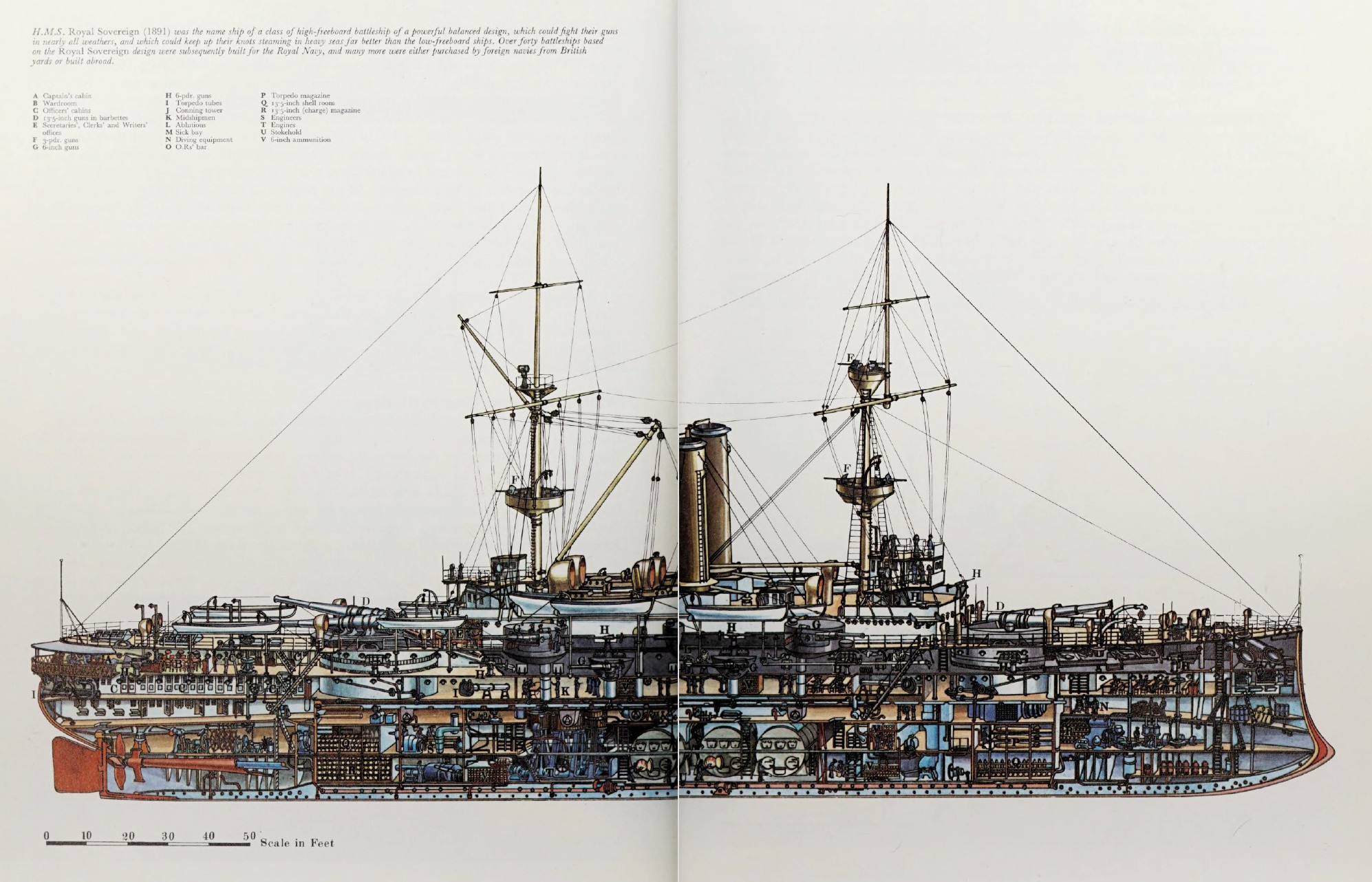
结论:在威廉·怀特担任造舰局长的时期,英国海军的战列舰设计进入了一个相对稳定的阶段,即所谓的前无畏舰时代。尽管这些军舰的整部布局较为接近,但子系统技术的进步(主要是克虏伯硬化装甲和中间口径火炮),还是让较晚些时候建造的军舰,在战斗力上明显超出了早些建造的那些军舰,但这也导致了她们的造价水涨船高。
三、英国海军的巡洋舰
巡洋舰(Cruiser),是吨位仅次于战列舰的舰种,也是每一支远洋海军都必须建造的舰种。
1、与战列舰相比,巡洋舰的形态和任务,都更为多样化。根据Norman Friedman的说法(British Cruisers: Two World Wars and After):
It is difficult to define a cruiser, the name implies a ship capable of cruising independently on a foreign station, as well as a long radius of action. Behind this name was the idea that the cruiser was smaller or more weakly armed than a battleship, yet still protected against enemy fire to some extent.
巡洋舰,是一种比较难定义的军舰。单从名称来看,这是一种能在海外区域独立行动,且具备持久续航能力的军舰。除此之外,巡洋舰的吨位要比战列舰更小,且武备也要弱于战列舰,但在一定程度上,仍然具备抵挡敌方火力的能力。
British cruisers had three roles. One was to protect seaborne trade against surface raiders...In the late nineteenth century, likely enemies all began building large, fast armoured cruisers and protected cruisers which might attack British trade. The Royal Navy built its own numerous fleet of large cruisers - each of which cost about as much as a battleship. Cruiser-building to protect trade was ruinously expensive because so many such ships were needed to cover so much trade. In effect the Royal Navy found itself building both a battle fleet and a cruiser fleet of similar or even greater cost.
英国巡洋舰具备三项职能。其一,是保护海上贸易,并对抗敌方的袭击舰。在19世纪后期,英国的潜在敌对国家,都在建造能够用于攻击英国海上贸易的巡洋舰,她们都具备大吨位、高航速的特征,其中有些是防护巡洋舰,另一些则是装甲巡洋舰。作为对应,英国海军自己也建造了大量的大吨位巡洋舰。由于海上贸易路线众多,因此为了覆盖这些航线,就需要大量的巡洋舰,而巡洋舰本身的造价又很高,有些造价甚至接近战列舰,因此针对通商保护需求的巡洋舰建造项目,是非常昂贵的。受此影响,皇家海军不单单要建造一支昂贵的战列舰队,还要建造一支同样昂贵,甚至更为昂贵的巡洋舰队。
Cruisers also operated with the fleet. As scouts, they were expected to find the enemy fleet while screening their own fleet from enemy discovery. If the British fleet was blockading an enemy port, British cruisers would operate off that port to raise the alarm when the enemy fleet sortied. To be viable, fleet scouts had to be powerful enough to survive in the face of the enemy’s most powerful cruisers. In addition to their scouting role, the cruisers operating ahead of or with the fleet were expected to shield it from enemy torpedo craft.
巡洋舰的第二项职能,是伴随舰队行动。她们可以作为舰队的侦察力量,去寻找敌方舰队,同时还能作为屏护力量,避免敌方发现已方舰队。如果英国舰队正在封锁一个敌方港口,那么英国巡洋舰就会在该港口外巡弋,并在敌方舰队出击时发出警报。作为舰队侦察力量的巡洋舰,必须具备足够强大的战斗力,以便能与敌方的最为强大的巡洋舰进行对抗。除了侦察职能之外,巡洋舰还可以部署在舰队前方、或伴随舰队行动,并保护其免遭敌方雷击舰艇的威胁。
The third important cruiser role was protecting the Empire...A cruiser was a particularly good package for colonial warfare: she combined a powerful gun armament with a substantial landing force of Marines and with command and control.
巡洋舰的第三项职能,是保卫大英帝国。巡洋舰是非常适合用于殖民地作战的,她们配备有强大的火炮,能搭载数量可观的陆战队,并且还能作为指挥中心使用。
2、现代意义上的巡洋舰,出现于19世纪末期。根据吨位,当时的英国海军巡洋舰,会分为三个等级。根据Norman Friedman的说法(British Cruisers of the Victorian Era):
The term cruiser was not widely used as a ship type until the 1880s. Before that ships were classified as frigates, corvettes, sloops. The categories were left over from the sailing ship era...The cruiser classification appeared, perhaps for the first time, in the 1 January 1878 edition of Classification of the Armoured and Unarmoured Ships and Vessels Constituting the Fighting and Sea-Going Divisions of the British Navy. It divided unarmoured cruisers into three classes. The official 1880 armament list included not only unarmoured ships described as cruisers, but also armoured cruisers. The ironclad cruiser categories had been dropped by 1888 in favour of a distinction between first-, second-, and third-class cruisers (whether or not protected).
在1880年代以前,巡洋舰这个词,很少被用来形容军舰类型。在那以前,执行此类任务的是巡防舰、轻巡防舰、还有巡逻炮舰。这些分类法,是从风帆海军时代遗留下来的。现代意义上的巡洋舰分类规则,最早似乎出现于1878年1月1日版的【英国海军的远洋作战舰船分类手册】中。在这本手册中,无装甲防护的巡洋舰,被分为了三个等级。在1880年的手册中,不单包括了无防护的巡洋舰,还包括了有装甲防护的巡洋舰。再后来,至1888年时,无论是否有装甲防护,巡洋舰都会按照一等、二等、三等进行分类。
3、在各类巡洋舰中,一等巡洋舰的吨位是最大的。根据防护形式的不同,有些一等巡洋舰属于防护巡洋舰,另一些则属于装甲巡洋舰。根据Jon Tetsuro Sumida的说法(In Defence of Naval Supremacy: Finance, Technology, and British Naval Policy, 1889-1914, P.19):
The first-class cruisers of the Naval Defence Act and Spencer program had not been provided with side armour because neither nickel-steel nor Harvey plates could be mounted in thicknesses that were sufficient to stop the projectiles of medium-caliber quick-firing guns over a great enough area of the hull to be effective without requiring prohibitively large increases in size and cost. These vessels instead relied upon an armoured deck that was located at the waterline, which shielded the vital machinery spaces and magazines. With the advent of Krupp armour, however, it became possible to cover a considerable area of the side of a first-class cruiser with plates that were capable of stopping medium-caliber quick-firer projectiles without involving unacceptable increases in size and expense.
海军防务法案及斯宾塞计划中建造的一等巡洋舰(埃德加级、王冠级),是不具备舷侧装甲带的。其原因是,在使用镍钢装甲或哈维硬化装甲的情况下,若想在舰体侧面布置足够大范围的、能抵挡中口径速射炮的装甲,就会导致军舰的尺寸变得过于巨大、造价变得过于高昂。所以,这些军舰是依靠布置在水线区域的防护甲板,来保护动力舱和弹药库等核心舱室的。在克虏伯硬化装甲出现后,一等巡洋舰也可以在不过分增加舰体尺寸和造价的情况下,配备覆盖范围足够大的、能够抵挡中口径炮弹的舷侧装甲带了。
4、装甲巡洋舰的战斗力,甚至可以与战列舰相媲美;但相应的,这种军舰的建造和运维成本也是非常高的。根据Nicholas A. Lambert的说法(Sir John Fisher's Naval Revolution, P.22-23):
In early 1898, the Admiralty laid down the Royal Navy’s first batch of armored cruisers. The six Cressy class were big ships. They carried a powerful main armament of 9.2-inch guns capable of piercing Krupp armor plate and a numerous battery of quick-firing 6-inch guns. In the Opinion of the then Director of Naval Construction, such vessels would be able to engage a battleship with some prospect of success. The Second Naval Lord and the Controller agreed that “they would be quite capable of dealing with many of the foreign battleships if they caught them singly.” Although the hulls of armored cruisers were actually larger than those of contemporary battleships, because they carried less armor their displacement was not so great and they thus did not cost so much to build. But because of the large number of stokers needed to feed the boilers when driving them at high speeds, armored cruisers required larger crews than battleships.
1898年初时,英国海军开始建造其第一批(现代意义上的)装甲巡洋舰——6艘克雷西级——这些军舰的吨位很大,搭载有威力强大、能够击穿(中等厚度的)克虏伯硬化装甲的9.2英寸主炮、以及配备在炮廓内的数量众多的6英寸副炮。在时任造舰局长威廉·怀特看来,这些军舰是能够与战列舰进行交战、且具备一定赢面的。当时的第二和第三海务大臣,也同意这个观点,并表示:“如果能抓住落单的外国战列舰的话,这些军舰完全有能力对付她们”。尽管这些装甲巡洋舰的舰体,要比同期的战列舰更大,但由于她们所配备的装甲较少,因此其排水量并没有战列舰那么大,且造价也要比战列舰低一些。但由于这些军舰具备更高的航速,因此配备了更多数量的锅炉,于是需要更多的司炉工。在此情况下,装甲巡洋舰的舰员数量,会比战列舰更多。
5、在19世纪末和20世纪初时,英法两国之间展开了装甲巡洋舰的建造竞赛,这导致了英国海军造舰费用的大幅攀升。根据Jon Tetsuro Sumida的说法(In Defence of Naval Supremacy: Finance, Technology, and British Naval Policy, 1889-1914, P.19-20):
The displacement of these vessels was some nine per cent, and their cost no less than 36 per cent, greater than that of their immediate protected cruiser predecessors. The French, however, responded by cutting back new battleship construction in order to concentrate on building fast armoured cruisers in large numbers: her program of 1897-98 included no fewer than seven such vessels in addition to the one of 1896 and the Russian ship of 1897. Britain was thus forced to order four armoured cruisers under the estimate of 1898-99, and an additional four vessels under a supplementary estimate later that same fiscal year. The displacement of the first four vessels was 18 per cent, and their cost some 32 per cent, greater than that of the armoured cruisers ordered under the previous year’s estimate. The displacement and cost of the four vessels built under the supplementary estimate, on the other hand, were substantially reduced by eliminating the 9.2-inch guns of the main battery, but they nevertheless remained more expensive than any of the protected cruisers that had been built previously. Six more armoured cruisers of the smaller type introduced with the supplementary estimate of 1898-99, were ordered under the estimates of 1899-1900 and 1900-01.
与英国海军最后的一等防护巡洋舰相比,克雷西级的吨位增加了约9%,造价提升则超过了36%。为了应对这个威胁,法国海军削减了战列舰建造计划,集中资源大批建造具备高航速的装甲巡洋舰:在1896年时,法国人已经建造了1艘装甲巡洋舰,在1897-98财年,他们又建造了7艘装甲巡洋舰。除此之外,俄国海军也在1897年时建造了1艘装甲巡洋舰。为了反制法国人的造舰计划,英国海军在1898-99财年时,建造了4艘装甲巡洋舰(德雷克级),同时又在同年晚些时候,以补充预算的方式,又额外增加了4艘装甲巡洋舰(蒙莫斯级)。前4艘(德雷克级)的吨位,要比克雷西级多出18%,造价则提高了32%;至于后4艘(蒙莫斯级),由于没有配备9.2英寸火炮,因此其吨位和造价显著降低了,但仍然比之前建造的任何防护巡洋舰都要更贵。此后,在1898-99至1900-01财年间,英国海军又陆续建造了6艘尺寸较小的装甲巡洋舰(蒙莫斯级)。
But the enormous British efforts were countered by French and Russian programs, which during the same period added eight vessels. Britain was thus compelled to increase her slender margin of superiority with an order for six armoured cruisers in 1901-02. With these vessels, an attempt was again made to save money by restricting size, which was only slightly greater than that of the reduced designs of the preceding three years. Armoured cruisers of such small dimensions could not, however, mount the 9.2-inch guns that were required to smash the Krupp medium armour of foreign vessels, and thus the two armoured cruisers ordered under the 1902-03 estimates were increased in displacement by some 25 per cent and in cost by no less than 36 per cent over the vessels ordered the year before in order to accommodate a main battery of 9.2-inch guns. The four armoured cruisers of the 1903-04 program were only slightly more expensive than the vessels of 1902-03 in spite of the fact that the secondary battery was strengthened by the substitution of 7.5-inch guns for 6-inch guns, but the three armoured cruisers ordered under the estimate of 1904-05 were provided with additional 7.5-inch guns, which resulted in a rise in displacement of 8 per cent, and in cost of almost 18 per cent, over that of their immediate predecessors.
在英国海军开足马力建造装甲巡洋舰的背景下,法俄两国也回应以大规模的建造计划:他们又建造了8艘新的装甲巡洋舰。在这种情况下,为了维持皇家海军的军舰数量优势,英国人又在1901-02财年时,建造了6艘装甲巡洋舰(德文郡级)。在设计这6艘军舰时,英国海军还是希望通过限制其吨位来降低造价,因此这些军舰(德文郡级)只比先前的那10艘军舰(蒙莫斯级)贵了一点点。然而,这种吨位的装甲巡洋舰,是无法配备9.2英寸火炮的(她们装备的是7.5英寸火炮),因此其火炮无法击穿外国军舰上安装的中等厚度的克虏伯硬化装甲。于是,在1902-03财年时,英国人回到了建造大吨位装甲巡洋舰的老路上,那2艘军舰(爱丁堡公爵级)再度配备了9.2英寸火炮,但其吨位增加了约25%,造价提升则超过了36%。1903-04财年的4艘装甲巡洋舰(勇士级),在副炮火力上有所加强,用7.5英寸火炮取代了原先的6英寸火炮,但其造价增长幅度并不大。1904-05财年的3艘装甲巡洋舰(米诺陶级),则配备了更多的7.5英寸火炮,导致其吨位上涨了8%,造价则上涨了将近18%。
6、当英国海军的一等巡洋舰,从防护巡洋舰转变为装甲巡洋舰后,除了吨位上涨和造价攀升之外,其主要职能也发生了明显的变迁。根据Scott M. Lindgren的说法(The Genesis of a Cruiser Navy: British First-Class Cruiser Development 1884-1909, P.xiii & P.61 & P.308 & P.310):
Blake, Powerful, Diadem and Edgar class were primarily intended for the trade protection role, although they too could realistically have been employed with fleets as heavy scouts and support for smaller cruisers if required.
布雷克级、埃德加级、强盛级以及王冠级(都是一等防护巡洋舰),主要是用于通商保护任务的;但实际上,她们也能用来伴随舰队,执行侦察任务,或用于支援小型的巡洋舰。
The first British cruisers to re-introduce side armour were specifically designed to function as the fast wing of a battlefleet, but were perfectly capable of independent operations should they be called upon to do so. Their successors, the even larger Drakes, were designed for the trade defence role with fleet duties a secondary capability...In effect, the largest first class cruisers had moved beyond a pure trade defence remit, and had become a second type of highly flexible capital ship, capable of multiple different operational functions.
德雷克级,是英国海军最早的现代意义上的装甲巡洋舰,她们是专门设计来用作战列舰队的快速侧翼的,但如果有必要的话,也完全能够前往海外单独执行任务。作为其后继舰型的德雷克级,则拥有更大的尺寸,但却是主要设计来执行通商保护任务的,而舰队任务则是其次要职能。至此,一等巡洋舰已经不再是纯粹的通商保护型军舰了,而是成为了一种能够执行多种不同作战任务的、具有高度灵活性的主力舰。
The Monmouths and subsequent Devonshires were modestly sized cruisers, primarily for trade defence...The Duke of Edinburgh class was an improvement on the preceding two types, largely on account of greater size, and marked a return to the fleet cruiser approach of the Cressys and Drakes.
蒙莫斯级和德文郡级的尺寸相对较小,她们主要是用来执行通商保护任务的。但接下来建造的爱丁堡公爵级(以及后续的勇士级和米诺陶级),则在尺寸上有所回升,并且回归了克雷西级和德雷克级的舰队巡洋舰的风格。
7、二等巡洋舰的吨位要小于一等巡洋舰,但其造价也更低,因此在数量上是占据优势的。根据D. K. Brown(Warrior to Dreadnought: Warship Design and Development 1860-1905)和Norman Friedman(British Cruisers of the Victorian Era)的说法:
Second Class cruisers were required in considerable numbers, mainly for trade protection, and hence they had to be cheap, whilst having the speed and armament quickly to overwhelm armed merchant raiders and small enemy cruisers. There can never be a complete answer to a dilemma of this sort and White’s designs of smaller cruisers were frequently criticised. It is interesting that Second Class battleships were unsuccessful, expensive in terms of capability and with a short service life. On the other hand, Second Class cruisers were built in large numbers and seen as valuable. The balance between quality and quantity is always difficult to draw and it would seem that the nature of cruising duties tipped the balance to numbers for these ships. On the other hand, a battleship had to be able to fight any ship of the enemy.
二等巡洋舰(吨位相对较小的巡洋舰),主要是用来执行通商保护任务的,此类任务对数量是有很高要求的,因此这种军舰的造价必须要低廉,同时又需要具备一定程度的武备和航速,以便快速解决敌方的武装商船或小型巡洋舰。但对于这种两头为难的需求,显然是无法给出两全其美的答案的,因此怀特(当时的造舰局长)的小型巡洋舰设计,经常遭到批评。有趣的是,二等战列舰(吨位相对较小的战列舰)向来是不太成功的,其战斗能力无法与造价相匹配,且其服役寿命也比较短。然而,二等巡洋舰却被认为是一种有价值的舰种,并且得到了大批量建造。数量与质量之间的平衡问题,始终是一个难点,但从巡洋任务的需求出发,二等巡洋舰的数量会比其质量更为重要。然而,战列舰却需要能对抗有可能遭遇的任何敌舰,因此其质量要比数量更为重要(所以二等战列舰不如一等战列舰有价值)。
The Medea class for the 1887 programme may be seen as the starting point...The Medeas were generally recognised as too small and the ‘Improved Medea’, which became the Apollo class of the Naval Defence Act, was much bigger...The last eight ships of the Naval Defence Act, the Astraea class, were 1000 tons bigger...The nine Eclipse class were a further 1000 tons heavier...The next stage was an Improved Talbot (Highflyer)...The Challengers marked the end of the series of medium fast cruisers begun with the Medeas about fifteen years earlier.
1887年造舰计划中的美狄亚级,可以认为是这些二等巡洋舰的起点,但她们的吨位太小了,因此其后继舰型,即海军防务法案中的阿波罗级,吨位增加了很多。海军防务法案中的最后8艘二等巡洋舰,阿斯特来亚级,吨位又增加了1,000吨。接下来的9艘日食级,又进一步增大了1,000吨。接下来,英国海军又建造了高飞级。最后,至挑战者级时,自美狄亚级起延续了15年的英国二等巡洋舰,落下帷幕了。
The Arrogant class ‘fleet ram’, generally classified as a second-class cruiser, but unrelated to contemporary ships of that type...The Arrogant class ‘fleet rams’ were soon described as ‘fleet cruisers’, as though no other cruisers had been conceived specifically for fleet work...While primarily designed for service with a fleet, they would be capable on occasion of separate service.
傲慢级,尽管通常被归类为二等巡洋舰,但实际上与同时代的其他二等巡洋舰并无关系。实际上,她们是一种伴随舰队行动的撞击舰(使用撞角去撞沉敌方军舰)。后来,她们又被描述为舰队巡洋舰,因为其他二等巡洋舰都不是专门为舰队任务设计的。不过,尽管她们主要是为舰队任务设计的,但她们依然具备在海外服役的能力。
8、三等巡洋舰的情况,则比较复杂,各种不同职能的都有:有些是用于执行侦察或通报任务的,另一些是用于驻派至殖民地的。根据Norman Friedman的说法(British Cruisers of the Victorian Era):
By 1882 the Board was interested in a protected seagoing torpedo ship...First Naval Lord Cooper Key proposed smaller fleet cruisers armed with torpedoes working with the battleships, which became the torpedo cruiser, and the progenitor of a series of third-class cruisers.
在1882年时,海军部委员会想要一种具备防护的、能够在外海上航行的鱼类舰艇。第一海务大臣库伯·基上将,提议建造一种配备有鱼雷的小型舰队巡洋舰,来伴随战列舰行动。这种军舰后来被命名为鱼雷巡洋舰,并成为了一系列的三等巡洋舰的起源。
In October 1886 White proposed a ship armed like Buzzard but carrying torpedoes, and provided with a protective deck...In that sense this was a midget protected cruiser. Moreover, because the new ship had little or no rig, she lacked the endurance of sloops, which had considerable sail power to supplement their engines...The Board approved White’s project...As completed, they were classed as third-class cruisers rather than sloops.
1886年10月时,怀特(造舰局长)提议,在秃鹰级巡逻炮舰的基础上,建造一种装备有鱼雷,并配备有防护甲板的军舰。这种军舰本质上就是超小型的防护巡洋舰。并且,由于这些军舰基本没有帆装,因此她们不具备巡逻炮舰那样的续航力——后者除了有蒸汽机之外,还可以依赖风帆来航行。海军部批准了怀特的设想。在建成后,这些军舰(杖鱼级)被归类为三等巡洋舰,而非巡逻炮舰。
Colonial Cruisers: Pearl Class...A Colonial Conference called in 1887, reached an agreement in which the Australian colonies would subsidize British warships to protect them. That included a new class of small cruisers ordered in 1888.
在1887年时,大英帝国内部召开了一个殖民地会议,他们达成的共识是,应由澳大利亚殖民地出资,让英国军舰来保护他们。在1888年时,英国海军建造了一批新的小型巡洋舰,这就是用于殖民地任务的珍珠级巡洋舰。
Two improved Barracoutas were included in the 1888-89 program: Barham and Bellona. The important change was far more powerful machinery, for much greater speed...White characterized the Barhams as swift protected despatch vessels for the Channel and Mediterranean Fleets...The Spencer Program (1893) included four more third-class cruisers envisaged as follow-on Barhams (Bellonas)...The ships (Pelorus Class) were not always assigned as envisaged: of six in commission in 1899, two were with the Channel Squadron and the others on foreign stations.
在1888-89财年的造舰计划中,英国海军建造了2艘杖鱼级的改进型:巴勒姆级。与杖鱼级相比,巴勒姆级的动力要强很多,因此具备更快的航速。巴勒姆级被怀特定义为是一种专门为海峡舰队及地中海舰队所准备的,拥有高航速、且具备一定防护水准的通报舰。在斯宾塞计划中,英国海军又建造了4艘巴勒姆级的后继舰,哑罗经级。然而,这些军舰在实际运用过程中,并未完全按照设想来使用:在1899年建成的6艘舰中,有2艘被派给海峡舰队了,但其他4艘则被派往了海外地区。
In the 1899-1900 program...the Board want something to work with the new Drakes as look-outs, linking them back to the main fleet they served...They materialized as the ‘Gem’ class.
在规划1899-1900财年的造舰计划时,海军部委员会希望建造一种能与德雷克级装甲巡洋舰搭配使用的小型巡洋舰,其作用是成为装甲巡洋舰和主力舰队之间的连接(当时还没有无线电通讯,因此需要依靠小型军舰来执行通报任务)。这个设想发展成了宝石级巡洋舰。
9、除了一等、二等、三等巡洋舰之外,英国海军还有一种侦察巡洋舰,她们是用来配合驱逐舰行动的。根据Norman Friedman(British Destroyers: From Earliest Days to the Second World War)和D. K. Brown(Warrior to Dreadnought: Warship Design and Development 1860-1905)的说法:
Destroyers needed small cruisers to lead them and to back them up. These ships were classed as scouts rather than as third-class cruisers. They were bought like destroyers, requirements being circulated to the likely builders, who created their own designs...Fairfield’s design had side armour over the machinery and a protective deck at the ends (Cammell Laird had side armour over the engines only, with a protective deck elsewhere). The other designs had conventional cruiser protective decks, sloped at the sides.
英国海军建造了一种用来指挥并支援驱逐舰的小型巡洋舰,他们将其归类为侦察巡洋舰,而非三等巡洋舰。这些军舰的采购方式,也是与驱逐舰类似的——海军部只给出造舰需求,具体设计则是由造船厂自行完成的。在各类侦察巡洋舰的设计中,大部分都是采用常规的防护甲板设计的;卡梅尔·莱德的设计在蒸汽机舱处布置了舷侧装甲,其余区域则是防护甲板;费尔菲尔德的设计则是在动力舱处(即蒸汽机舱和锅炉舱)布置了舷侧装甲,舰艏舰艉区域则是防护甲板。
The Armstrong ships were significantly faster than their rivals though all met the required 25kts. Their original armament was ten 12pdrs, soon increased to twelve. This was seen as inadequate and in 1911-12 they were re-armed with nine 4in. Though they were too small and too weakly armed to be seen as entirely successful, the Armstrong style (due to Phillip Watts) was liked and formed the basis for many Admiralty designs.
这些侦察巡洋舰的航速指标是25节,各公司的设计都能满足该要求,但阿姆斯特朗的设计,明显要比其他公司的设计跑得更快。在武备方面,她们起初配备的是10门12磅火炮,后来很快增加至12门12磅火炮,但仍然被认为火力不足,于是在1911-12年间,更换为9门4英寸火炮。由于这些军舰的尺寸过小,武备也太弱,因此并不算非常成功的设计。但是,由于菲利普·瓦茨的关系,阿姆斯特朗设计的版本,成为了不少海军部设计的军舰的原型(菲利普·瓦茨是威廉·怀特的继任者,两人在担任造舰局长之前,都曾任职于阿姆斯特朗公司)。
最贵、最重要的巡洋舰:能参与舰队决战的装甲巡洋舰
下图中展示的,是阿基里斯号装甲巡洋舰,她属于勇士级,是一艘非常典型的英国海军的末代装甲巡洋舰。这种军舰是当时最贵、最重要的巡洋舰,拥有仅次于战列舰的火力和防护,且拥有比战列舰更高的航速,因此具备参与舰队决战的能力。
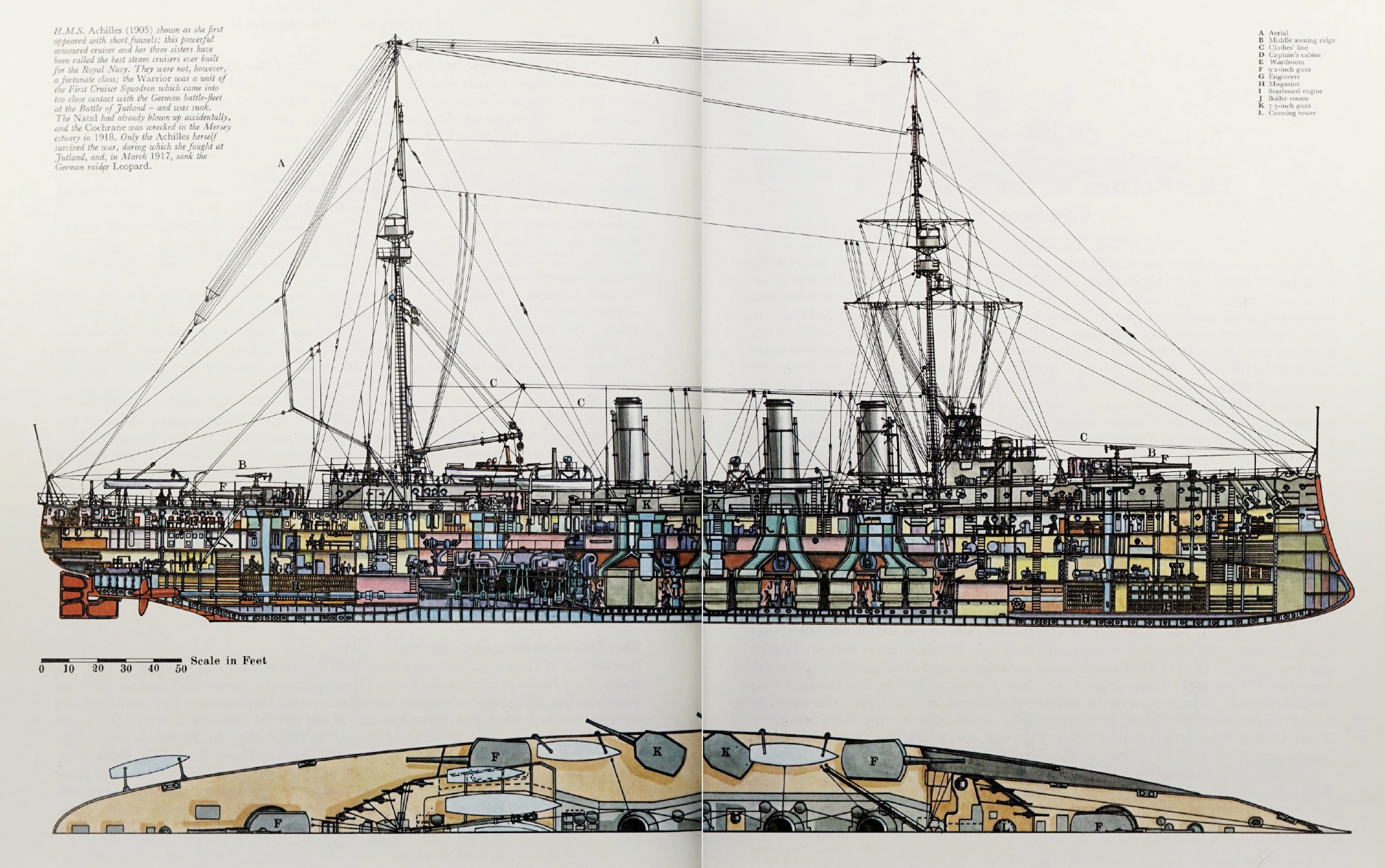
结论:维多利亚时代晚期的英国巡洋舰,会根据吨位的不同,分为一等、二等、三等巡洋舰。这些军舰,大部分是为通商保护任务设计的,有一部分是为舰队任务设计的,还有少部分是为殖民地任务设计的。另外,还有一些是专门用来伴随驱逐舰的侦察巡洋舰。其中,二等、三等、侦察巡洋舰的吨位和造价,还是比较低的,但一等巡洋舰的吨位和造价,则在造舰竞赛和子系统技术进步(主要是克虏伯硬化装甲和更大口径的火炮)的双重影响下水涨船高,这导致了造舰费用的快速攀升。
四、英国海军的轻型舰艇
对于当时的英国海军来说,除了战列舰和巡洋舰以外的作战舰艇,如巡逻炮舰(Sloop)、炮舰(Gun Vessel)、炮艇(Gunboat)、鱼雷艇(Torpedo Boat)、鱼雷炮艇(Torpedo Gunboat)、驱逐舰(Destroyer)、潜艇(Submarine)等,基本都可以归类为轻型舰艇(Flotilla Craft)。
1、在鱼雷出现之前,海军中的轻型舰艇,主要是各式各样的炮舰和炮艇。根据D. K. Brown的说法(Warrior to Dreadnought: Warship Design and Development 1860-1905):
The smaller classes of warship had few technical novelties. All their perceived roles, both in peace and war, put an emphasis on numbers, which in the limited budgets of the day, meant they had to be cheap to buy and economical to run. It is easy to show that ‘better’ ships were possible but any comparison must be on the more difficult ‘whole force’ basis as better ships would be more expensive and hence fewer would be available. However, the cheap ship, however numerous, must have adequate capability...The majority of the new, small ships were built prior to 1880 when their work was increasingly taken over by Second and Third Class cruisers.
这些吨位较小的舰艇,几乎是没有技术亮点的。结合其职能来看,无论是在和平时期还是战争时期,这些军舰都是以数量来衡量的。在造舰预算的限制下,这些军舰的造价自然是很低的,且运维成本也很低。想要造出一艘更好的军舰并不难,但从整体的角度看,单艘更好的军舰,就意味着更贵的价格和更少的数量。不过,尽管这种军舰很廉价,更强调数量,但必要的作战能力还是得具备的。这些小型军舰,大多数都建造于1880年之前。此后,她们所承担的职能,就逐渐由新出现的二等和三等巡洋舰接替了。
The distinction between corvette and sloop and also to a lesser extent between sloop and gun vessel was unclear. In appearance, layout and technical features, sloops were generally small corvettes. Corvettes were commanded by a captain, sloops and gun vessels by commanders and gun boats by lieutenants.
轻巡防舰和巡逻炮舰之间的区别,是不太明晰的。而巡逻炮舰和炮舰之间的差别,也不算很明确。从外观、布局、技术特征等角度看,巡逻炮舰就是吨位较小的轻巡防舰。轻巡防舰的舰长是上校军衔的,巡逻炮舰和炮舰则是由中校或少校担任舰长的,至于炮艇则是由尉官负责指挥的。
2、鱼雷问世之后,随之出现了一种能对主力舰构成威胁的轻型舰艇:鱼雷艇。根据Norman Friedman的说法(British Destroyers: From Earliest Days to the Second World War):
The Royal Navy bought HMS Lightning (TB 1) from Thornycroft. The world’s first Whitehead torpedo boat, she was ordered and delivered in 1877. Lightning was apparently not particularly successful, spending her career as a tender to HMS Vernon, the torpedo school. However, she was interesting enough to inspire further orders from Thornycroft. The Admiralty also sought alternative designs from other builders. In parallel with the first-class boats, Thornycroft received contact for second-class craft, which could be carried on board larger ships.
世界上第1艘配备了自航式鱼雷的鱼雷艇,是1877年时,英国海军在桑尼克罗夫特公司订购的闪电号。这艘鱼雷艇似乎并不太成功,因此其服役生涯,是作为鱼雷学校的补给船来度过的。不过,她还是激发了英国海军的兴趣,因此他们又向桑尼克罗夫特公司以及其他的造船厂,订购了更多的鱼雷艇。除了这些尺寸较大的一等鱼雷艇之外,英国海军还向桑尼克罗夫特(以及其他公司)订购了尺寸较小的二等鱼雷艇,后者的尺寸较小,可以由大型军舰携带。
The Royal Navy conducted its first formal torpedo boat manoeuvres in summer 1884. Although the trials showed that British torpedo boats could not effectively accompany the fleet to sea, the French thought (or hoped) otherwise. In their 1884 exercises, a torpedo boat flotilla intercepted and attacked a group of ironclads at sea. On another occasion torpedo boats accompanied ironclads to sea in a gale.
在1884年夏天时,英国海军开展了第一次正式的鱼雷艇演习。其结果表明,英国鱼雷艇并不能有效的伴随舰队出海。然而,法国人却有不同的观点,在他们于1884年举行的演习中,一队鱼雷艇在大海上拦截并攻击了一群大型军舰。在另一个场合,在海上刮着大风的情况下,鱼雷艇伴随大型军舰出海了。
3、为了反制鱼雷艇对主力舰构成的威胁,英国海军发明了鱼雷炮艇。根据Norman Friedman(British Destroyers: From Earliest Days to the Second World War)和D. K. Brown(Warrior to Dreadnought: Warship Design and Development 1860-1905)的说法:
Barnaby had long maintained that battleships should be defended against the threat of torpedoes by torpedo boat catchers. Such vessels, which became known as torpedo gunboats (TGB), were designed just as he resigned. Barnaby believed they were the smallest ships which could keep up with the battlefleet at sea...The first TGB was Rattlesnake, laid down in 1885...The Grasshoppers were essentially repeat Rattlesnakes with slightly lighter displacement...Sharpshooters were in effect an improved Rattlesnake with a forecastle for sea-keeping...The next eleven ships were Alarm class...The Halcyons were the ultimate version of the Royal Navy torpedo gunboat.
纳撒尼尔·巴纳比(威廉·怀特之前的造舰局长)一直认为,应该建造一种鱼雷艇捕捉舰,来保护战列舰免遭鱼雷威胁。这种设想被发展成了鱼雷炮艇。在巴纳比辞职之时,这种军舰正处在设计阶段。在巴纳比看来,这是尺寸最小的能够伴随战列舰队在海上行动的军舰。第1艘鱼雷炮艇,是1885年时下水的响尾蛇号。接下来建造的蚱蜢级(3艘),基本上就是吨位略微减少的响尾蛇号。再接下来的神射手级(13艘),可以认为是带有艏楼、航海能力有所改善的响尾蛇号。接下来,英国人又建造了11艘警报级。英国海军最后的鱼雷炮艇,是树精级(5艘)。
4、至1890年代时,英国海军又发明了驱逐舰,来应对鱼雷艇。根据Norman Friedman(British Destroyers: From Earliest Days to the Second World War)和D. K. Brown(Warrior to Dreadnought: Warship Design and Development 1860-1905)的说法:
In 1888, the French produced ‘high seas’ (Haut-Mer) torpedo boats capable of operating outside their harbours. The English Channel in particular was likely to become far more dangerous. If the British fleet could no longer blockade French Channel ports, then French commerce raiders might easily emerge. Something was needed that could catch French torpedo boats in the open sea.
1888年时,法国海军开始建造具有一定远航能力的“公海”鱼雷艇。这些军舰,会让英吉利海峡变得非常危险——原因在于,如果英国舰队不再能蹲守在法国港口外,对其进行封锁的话,那么法国海军的袭击舰,就能轻易地溜进大洋,对英国商船展开袭击行动。在此情况下,英国海军势必得想出一种办法,来对付这种能在大海上航行的法国鱼雷艇。
By 1892 it seemed that the torpedo gunboat was too big, expensive and slow to form an adequate defence against torpedo boats. The big torpedo boat, such as Swift (TB 81), showed promise but were still too small. The Controller, Fisher, saw the solution and, following discussions with Yarrow and Thornycroft, ordered the first ‘torpedo boat destroyers’. These were enlarged torpedo boats of 275-280 tons, a speed of 26kts on trial, and an armament of one 12pdr, three 6pdr and three 18in torpedo tubes.
至1892年时,人们认为,鱼雷炮艇太大、太贵,并且航速也比较慢,不足以用来抵挡鱼雷艇。另一方面,尺寸较大的鱼雷艇,比如敏捷号,虽然有一定的反雷击潜力,但还是太小了。当时担任第三海务大臣的费舍尔(就是后来推动无畏舰革命的那位),在与亚罗公司和桑尼克罗夫特公司商讨之后,提出了解决方案,并订购了世界上第一批鱼雷艇驱逐舰(驱逐舰的完整名称)。这些驱逐舰,实际上是大号的鱼雷艇,其排水量在275-280吨,试航航速可达26节,武备是1门12磅火炮、3门6磅火炮以及3具18英寸鱼雷发射管。
In all, there were 111 generally similar boats, the 6 original 26-knotters, 36 ‘27-knotters’, 66 ‘30-knotters’ and 3 special ‘33-knotters’.
英国海军总共建造了111艘在设计上大同小异的早期型的驱逐舰,包括:最初的6艘26节驱逐舰、36艘27节驱逐舰、66艘30节驱逐舰、以及3艘特别的33节驱逐舰。
It was soon realised that the 30kt trial speed of early destroyers was unrealistic as the power could not be sustained. This was due mainly to lack of stokers and they also soon lost speed in a seaway, mostly due to their low freeboard. This led to a radical reconsideration of the requirements for destroyers and their configuration. The River class were given a high forecastle, much improving their performance in head seas.
很快,英国海军就意识到,这些早期型的驱逐舰,尽管能在试航中达到30节航速,但却无法以这种航速持续航行。其主要原因,是司炉工数量不足,且由于其干舷较低,因此在海况较高时航速会显著下降。因此,英国人改变了驱逐舰的设计要求。接下来的河流级驱逐舰,采用了高干舷的设计,因此在高海况下的航行能力有了显著提高。
5、尽管在水面鱼雷舰艇的发展上,英国海军扮演了先驱的作用,但在潜艇的发展上,英国人却表现出了不一样的态度。根据D. K. Brown(The Grand Fleet: Warship Design and Development 1906-1922)和Nicholas A. Lambert(Sir John Fisher's Naval Revolution, P.39-41)的说法:
One may see Fulton’s demonstration of 1804 as marking the start of submarines in Britain. Fulton had built a submarine in France, the Nautilus, but became disillusioned with his treatment and crossed the Channel. In a demonstration backed by the Prime Minister, Pitt, he sank the brig Dorothea off Walmer. This drew Lord St Vincent to remark: ‘Pitt was the greatest fool that ever existed to encourage a mode of warfare which those that command the sea did not want, and which, if successful, would deprive them of it.’
美国人富尔顿在1804年时所展示的潜艇,可以认为是英国潜艇发展史的起点。此人先是在法国建造了1艘名叫鹦鹉螺号的潜艇,但后来又转而为英国效力了。在当时的英国首相小威廉·皮特的支持下,富尔顿用他的潜艇,在沃尔默海滩附近,击沉了多萝西娅号双桅帆船。对此,当时担任海军大臣的圣文森特伯爵评论道:“皮特就是有史以来最愚蠢的傻瓜,他居然会去鼓励推动一种对英国不利的作战方式。如果这种战法得以成功的话,那将会导致英国失去制海权”。
For almost one hundred years, the Board of Admiralty’s policy toward submarines rested upon the premise that the Royal Navy must not do anything to “justify or encourage” rival navies from sponsoring their development.
在此后将近100年的时间跨度里(从19世纪初到20世纪初),海军部对待潜艇的态度都是:我们决不能采取任何行动,来刺激敌对国家资助潜艇的研发,也不能为他们提供这么做的合理借口。
Up to the end of the nineteenth century there were no practical submarines but at about that date a number of reasonably successful designs appeared in France and the USA...The RN did not wish to purchase boats from France, a potential enemy, and were offered an attractive deal: Five submarines of Holland design would be built by Vickers. The American company would supply technical assistance.
在19世纪末之前,潜艇一直都没有达到实用化的阶段。但在19世纪末时,法国人和美国人,分别都拿出了一些相对较为成功的潜艇设计。英国海军不希望从法国,一个潜在的敌对国家处购买潜艇,因此选择购买美国的潜艇设计。双方谈妥的协议是,由维克斯公司建造5艘美国人霍兰德所设计的潜艇,美国公司会为前者提供技术支持。
‘A’, ‘B’ and ‘C’ classes: These successors to the Holland boats were designed by Vickers and though they may be regarded as improvements on the Hollands, there was no American contribution...In service, the ‘As’ were seen as only a slight improvement on the Hollands but the ‘Bs’ and even more so the ‘Cs’ were thought to be fully-capable warships.
在霍兰德型潜艇之后,维克斯公司又相继设计了A级、B级、C级潜艇。这些潜艇可以认为是霍兰德潜艇的改进型,但美国公司并未参与这些项目。从服役后的实际表现来看,A级相比霍兰德型的改进很有限,但B级和C级则已经具备作战能力了。
终极的鱼雷舰艇:鱼雷艇驱逐舰
下图中展示的,是大黄蜂号驱逐舰,她属于灾难级,是世界上第一批驱逐舰。这些军舰起初是用来对抗法国海军的鱼雷艇威胁的,但在后续发展过程中,她们取代了鱼雷艇,成为了最重要的鱼雷舰艇。
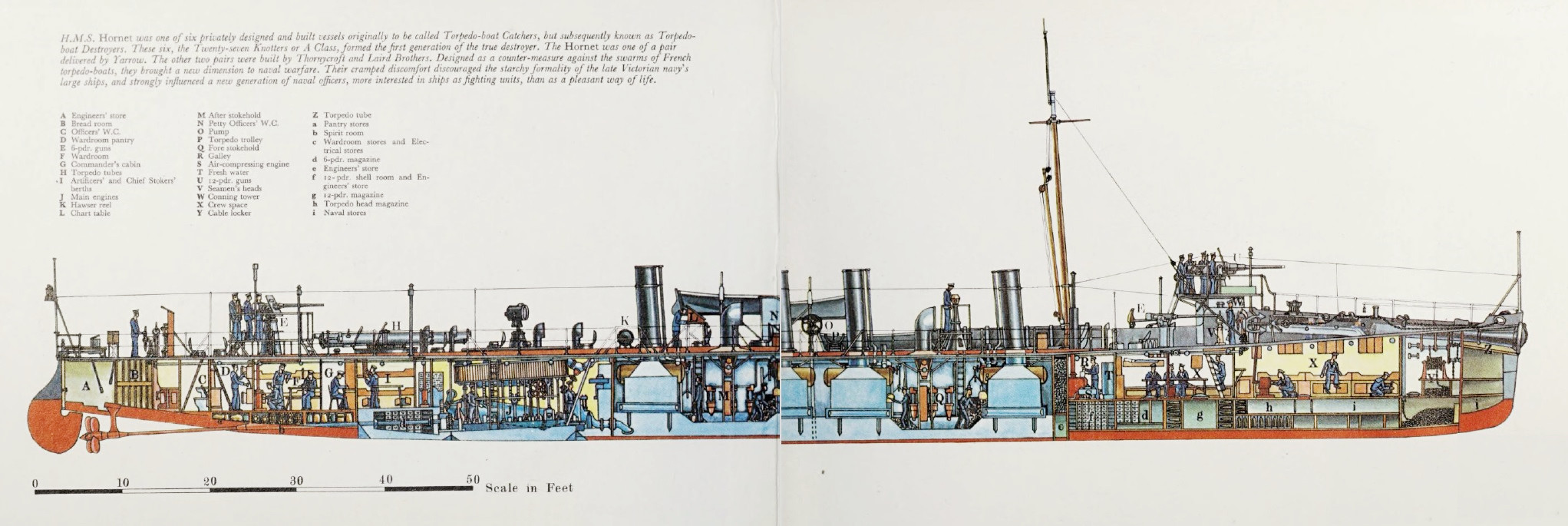
海战模式的颠覆者:潜艇
下图中展示的,是A1号潜艇,她属于A级,是英国海军第一型由英国公司设计的潜艇。当时的潜艇还很原始,但她们很快就将颠覆现有的海战模式。

结论:当时的英国海军,有多种不同类型的轻型舰艇。其中,巡逻炮舰、炮舰、炮艇,主要是在殖民地等海外地区活动的,在列强之间的战争中并无多大价值。而鱼雷艇和鱼雷炮艇,则都是围绕着鱼雷诞生的舰艇,不过她们后来都被驱逐舰淘汰了。驱逐舰,是维多利亚时代晚期最重要的轻型舰艇,并得到了大量建造。至于潜艇,尽管在日后得以发展为大放光彩的舰种,但在当时还处于发展初期阶段。
五、英国海军军费的快速上涨
在英法俄争霸的大背景下,英国在军舰建造方面耗费了大量经费,导致其海军军费快速上涨。
为了应对这个问题,英国政府甚至采用了贷款的方式,来筹措经费。根据Nicholas A. Lambert的说法(Sir John Fisher's Naval Revolution, P.29):
At the end of the nineteenth century, the spiraling trend in naval expenditure was a major worry for most British politicians, who were still unwilling to alienate the electorate by raising taxation to pay for a larger navy. To avoid this the government resorted to borrowing. While paying for current expenditure by adding to the national debt was always politically out of the question, since 1895 Parliament had relaxed this “principle of national finance” by passing an act that allowed improvements in naval works to be paid for by the issue of thirty-year bonds. As a gesture towards fiscal orthodoxy, though, the interest payable on these bonds was deducted from the naval estimates account...This practice of paying for naval works by money raised on the capital markets rather than out of current revenue was continued until 1904, when the parliamentary finance committee protested it must stop.
在19世纪末时,快速上涨的海军军费,成为了绝大部分英国政客非常担忧的问题——如果为了建设海军而增加税收的话,很可能会招致选民的敌意。为了避免这个困境,政府选择通过贷款来解决问题——尽管他们并不愿意通过增加国债的方式来支付开支,但自1895年起,议会降低了“国家财政的标准”,他们通过了一项“海军设施法案”,允许以30年期债券的方式,来为海军基础设施建设筹措费用。为了平息财政上的传统派的不满,他们还规定,这些债券的利息,会从海军预算里扣除。直到1904年时,英国议会的财政委员会,才叫停了这种在资本市场上为海军基础设施建设筹措费用的做法。
Notwithstanding the passage of successive naval works acts, paying for warships by longterm borrowing was never an option for any British government.
不过,基础设施建造费用是一码事,但军舰建造费用又是另一码事了——对于后者,英国政府并未使用长期债券的方式来筹措费用。
1889-1905财年间的英国海军军费
从左至右,每一列分别是:财年、净开支预算、净开支预算+补助拨款、净开支预算+补助拨款+超预算开支、以及总有效开支(净开支预算+补助拨款+超预算开支-利息)。
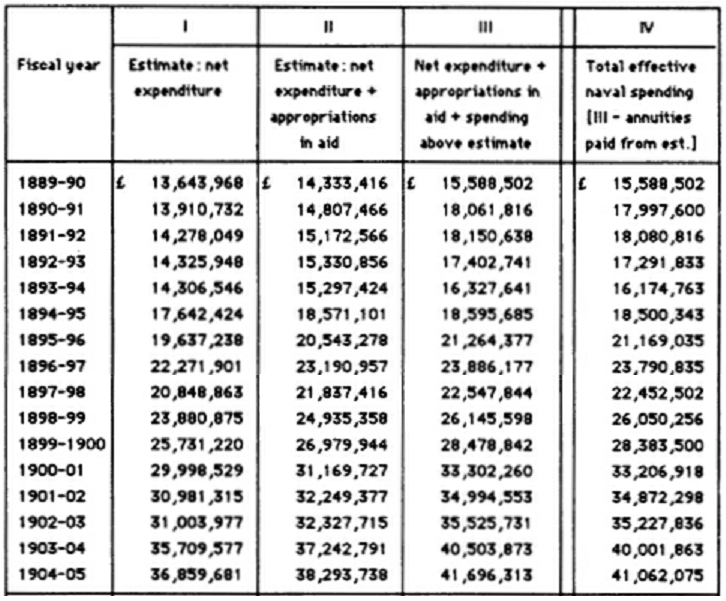
自1889-90财年至1904-05财年间,英国海军的年度总有效开支,从1,559万英镑上涨到了4,106万英镑,涨幅为163%(在此期间的通货膨胀仅为6%)。
1889-1905财年间,英国海军的造舰费用(不含武备)
从左至右,每一列分别是:财年、战列舰的造舰费用、巡洋舰的造舰费用、轻型舰艇的造舰费用、以及总造舰费用。
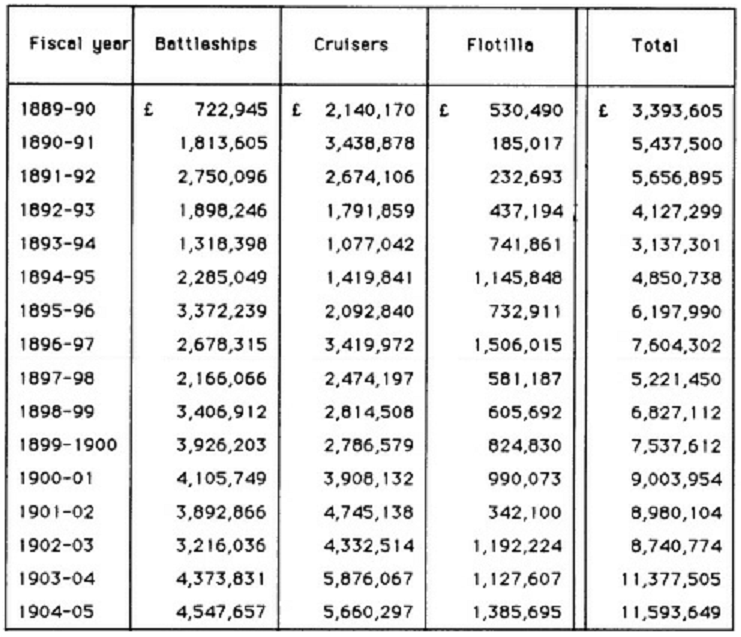
自1889-90财年至1904-05财年间,英国海军的造舰费用,从339万英镑上涨到了1,159万英镑,涨幅为242%。
以单舰造价而论,战列舰的造价当然要比巡洋舰更贵(在1889-1905财年间,英国海军的一等战列舰的造价在90-160万英镑之间,二等战列舰的造价在60-75万英镑之间,一等装甲巡洋舰的造价在75-140万英镑之间,一等防护巡洋舰的造价在40-75万英镑之间,二等巡洋舰的造价在20-30万英镑之间,三等巡洋舰的造价在10-20万英镑之间)。
但是,由于巡洋舰的数量远多于战列舰(在1889-1905财年间,英国海军总共建造了50艘战列舰,其中47艘一等战列舰,3艘二等战列舰;作为对比,同样是在1889-1905财年间,英国海军总共建造了128艘巡洋舰,其中19艘一等防护巡洋舰、35艘一等装甲巡洋舰、47艘二等巡洋舰、19艘三等巡洋舰、8艘侦察巡洋舰),因此巡洋舰的总造舰费用,反而要略高于战列舰。
至于轻型舰艇,尽管数量众多,但由于单舰造价十分低廉,因此其总造舰费用远小于前两类军舰。
1889-1905财年间,英国海军的巡洋舰的造舰费用(不含武备)
从左至右,每一列分别是:财年、一等巡洋舰的造舰费用、二等巡洋舰的造舰费用、三等巡洋舰的造舰费用、以及巡洋舰的总造舰费用。
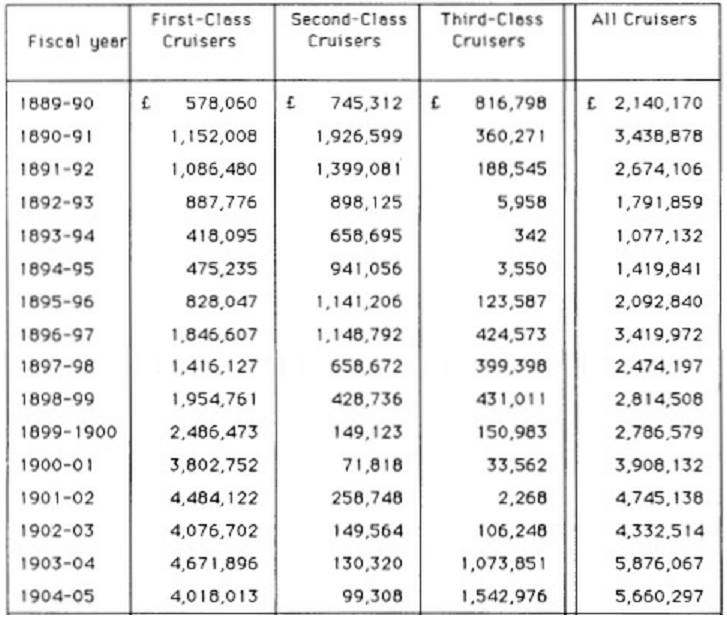
可以看到,在1896-97财年之前,二等和三等巡洋舰的造舰费用之和,明显高于一等巡洋舰的造舰费用;但在1896-97财年之后,一等巡洋舰的造舰费用大大超出了二等和三等巡洋舰的造舰费用之和,这是为什么呢?
首先,1896-97财年,恰好是英国海军的一等巡洋舰设计,从防护巡洋舰切换至装甲巡洋舰的那一年。这种切换,导致了一等巡洋舰的单舰造价的大幅提升。
其次,由于造舰竞赛的关系,一等装甲巡洋舰的建造数量较多,占据了巡洋舰造舰费用的大头,进而导致二等巡洋舰的建造数量明显下降(在1889-1896财年间,英国海军总共建造了19艘一等防护巡洋舰、42艘二等巡洋舰、9艘三等巡洋舰;作为对比,在1897-1905财年间,英国海军总共建造了35艘一等装甲巡洋舰、5艘二等巡洋舰、10艘三等巡洋舰、8艘侦察巡洋舰)。
由于以上两方面因素的影响,自一等装甲巡洋舰取代一等防护巡洋舰后,英国海军的巡洋舰造舰费用,就有相当大的一部分,都用在了这类军舰上。
1889-1905财年间,英国海军的轻型舰艇的造舰费用(不含武备)
从左至右,每一列分别是:财年、巡逻炮舰的造舰费用、炮艇的造舰费用、鱼雷艇和鱼雷炮艇的造舰费用、驱逐舰的造舰费用、以及潜艇的造舰费用。

在轻型舰艇中,造舰费用占比最大的,早期是鱼雷艇和鱼雷炮艇,后期则是驱逐舰。她们的共同点,是都属于鱼雷舰艇。
1889-1905财年间,英国海军的军舰运维费用
从左至右,每一列分别是:财年、燃油费用、弹药费用、重建及大修费用、小修及维护费用、以及军舰运维费用总和。
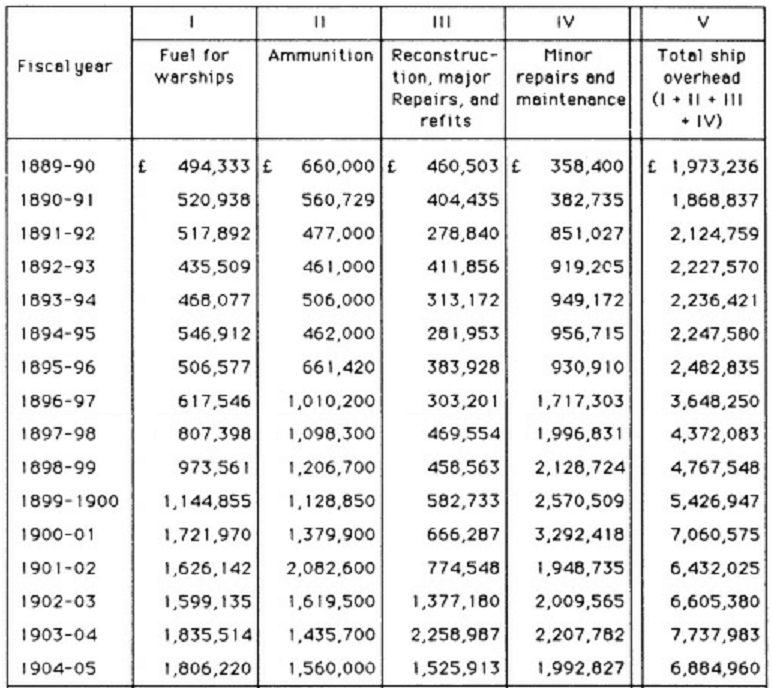
自1889-90财年至1904-05财年间,英国海军的军舰运维费用,从197万英镑上涨到了688万英镑,涨幅为249%。
1889-1905财年间,英国海军的造舰、运维、武备、以及总装备费用
从左至右,每一列分别是:财年、造舰(不含武备)及运维费用之和、武备费用、以及总装备费用(造舰费用、军舰运维费用、以及武备费用的总和,就是总装备费用)。
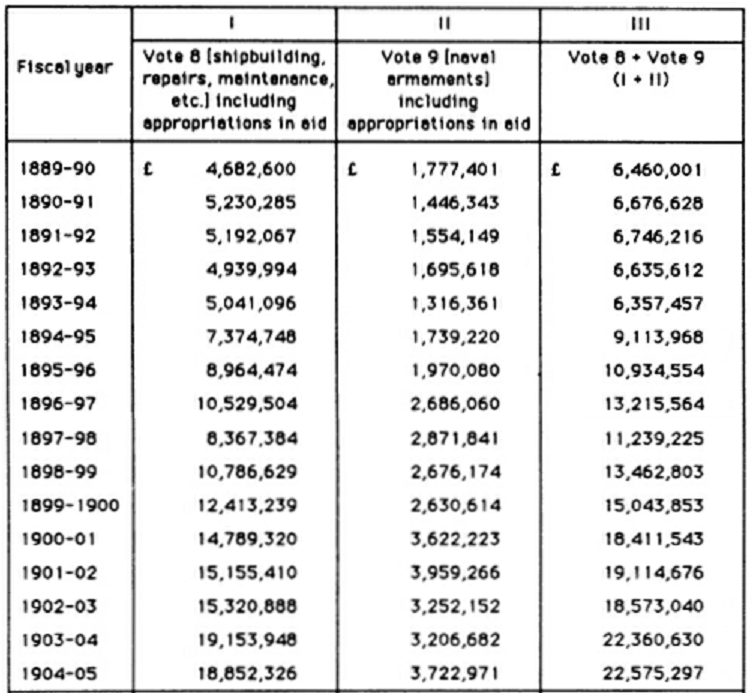
自1889-90财年至1904-05财年间,英国海军的武备费用,从178万英镑上涨到了372万英镑,涨幅为109%;总装备费用,则从646万英镑上涨到了2,258万英镑,涨幅为250%。
1889-1905财年间,英国海军的人员费用
从左至右,每一列分别是:财年、工资、餐饮、半薪(有军衔但无实际职务的军官的薪资)、退休金、以及预备役相关费用。
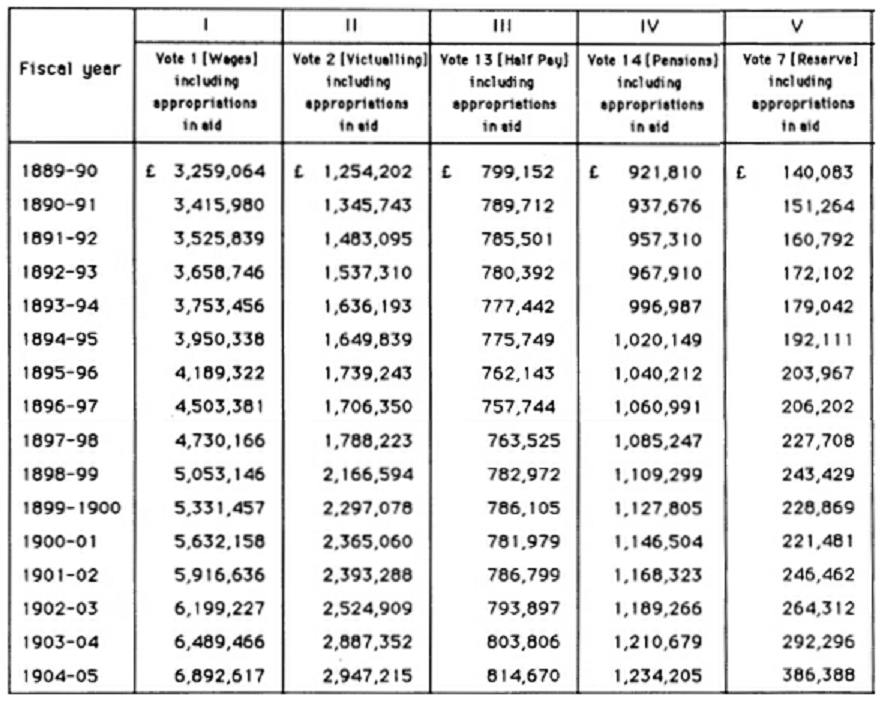
由于新建造的军舰数量很多,且战列舰和装甲巡洋舰都需要大量的舰员,因此工资和餐饮开支必然是持续上涨的。在此情况下,自1889-90财年至1904-05财年间,英国海军的年度人员费用,从637万英镑上涨到了1,228万英镑,涨幅为93%。
1889-1905财年间,英国海军的基础设施费用
从左至右,每一列分别是:财年、基础设施费用、海军设施法案的利息、扣除海军设施法案的利息之后的基础设施费用、海军设施法案下的开支、以及基础设施的总有效开支。
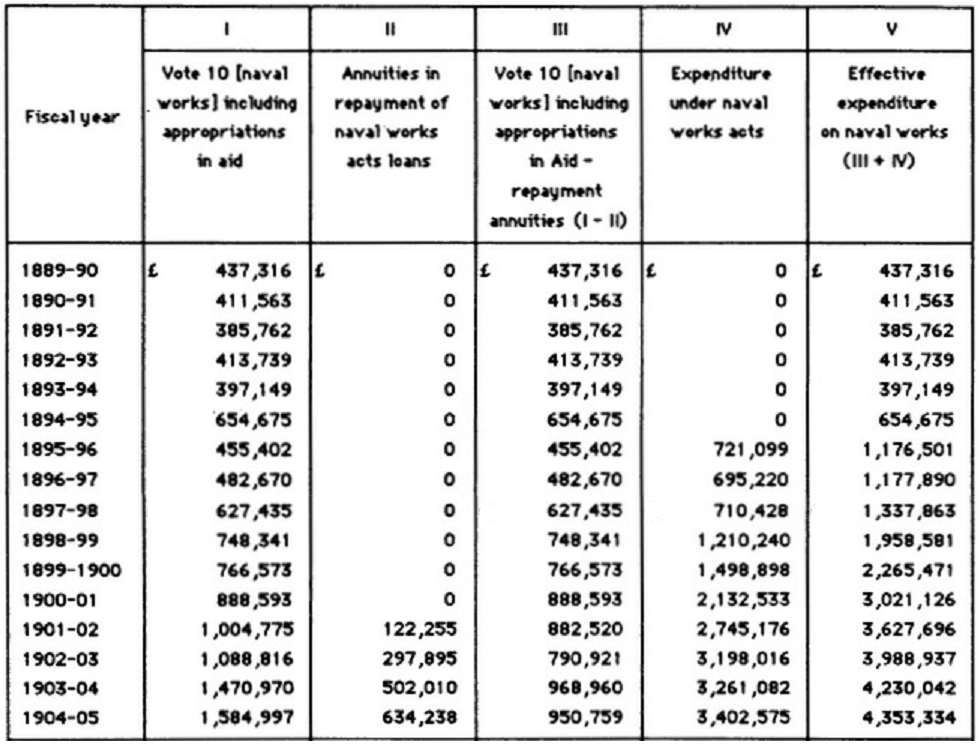
为了建造并维护更大、更先进的军舰,就需要对现有的皇家船厂及港口设施进行升级;与此同时,岸上的弹药库、燃料库等设施,也需要得到扩充;这些因素都会导致基础设施费用的增加。在此情况下,自1889-90财年至1904-05财年间,英国海军的年度基础设施费用,从44万英镑上涨到了435万英镑,涨幅为885%。
1889-1905财年间,英国海军军费中,各项费用的占比情况
从左至右,每一列分别是:财年、人员费用占比、基础设施费用占比、装备费用占比、以及其他费用占比。
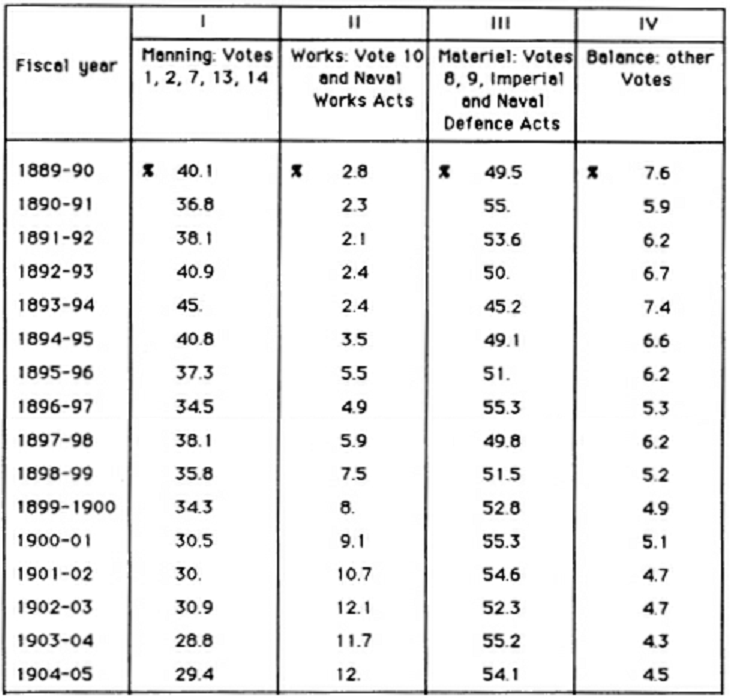
装备费用(包含造舰、武备以及军舰运维费用)一直是海军军费中的最大部分,人员费用是第二大部分,基础设施费用则是第三大部分。
高昂的装备费用,在很大程度上都是战列舰和装甲巡洋舰导致的;人员费用,同样有很大一部分是由于战列舰和装甲巡洋舰导致的;而基础设施费用,有许多也是为了建造并维护战列舰和装甲巡洋舰而花费的。毫不夸张的说,大量建造价格高昂的战列舰和装甲巡洋舰,是导致英国海军军费上涨的最主要的原因。
结论:综上所述,为了应对法俄两国的威胁,英国海军建造了为数众多的战列舰和装甲巡洋舰,同时也导致了造舰费用的大幅上涨、乃至于军费的整体上涨。其结果是,一方面,英国海军的实力得到了快速增长,但另一方面,英国政府也承受了很大的财政负担。 |
